WINNERS
TOP PROJECTS FROM THE 2023 SWEET HEAT CONTEST


Follow Us On @hpacmag IMPROVING PROCUREMENT HEAT PUMP EXPERIENCE CIPHEX WEST PREVIEW OCTOBER 2023 HPACMAG.COM
Safe For All Systems
(Including Aluminum and Solar)
Premier Inhibitors
Higher Temperature Rated Phosphate and Nitrate Free Low Viscosity
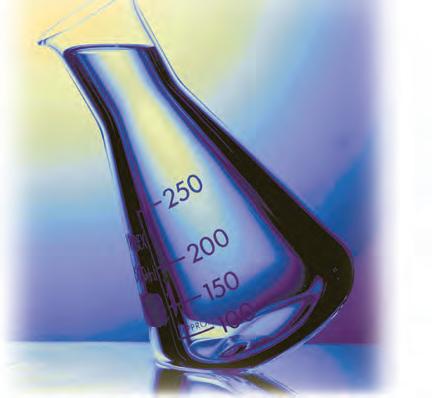





For more benefits ask your local wholesaler or visit chemfax.com


All Glycols
Created Equal
Not
Are
CHEM-FROST
HEAT TRANSFER FLUID - INHIBITED PROPYLENE GLYCOL COMPARISON CHART

ChemFrost100%BrandRBrandOBrandHBrandUBrandD Pail Size 20L18.9L18.9L20L20L18.9L PG Concentrate Amount 95/592/8N/A94/695/595/5 Aluminum Safe YES LIMITED TO 65C NONONONO Solar Safe YES NO SOME LIMITED NONONO Geothermal Safe YES LIMITED N/AN/AN/AN/A Temperature Rating 325F275F250F250F250F220F Viscosity @ 50% 100F 5.5cP8.5cP10cP10cP10cP10cP Boiling Point @ 100% 417F370F370F370F370F370F CFIA Approved YESYES NONO YES NO Raw PG Grade FOOD INDUSTRIAL GRADE INDUSTRIAL GRADE INDUSTRIAL GRADE INDUSTRIAL GRADE INDUSTRIAL GRADE Purity of Propylene Glycol 99.94%+ N/A98%N/AN/AN/A Phosphate / Nitrate NONE YESYESYESYESYES Inhibitor Type PDT NON-TOXIC DIPOTASSIUM PHOSPHATE DIPOTASSIUM PHOSPHATE DIPOTASSIUM PHOSPHATE DIPOTASSIUM PHOSPHATE DIPOTASSIUM PHOSPHATE LEED YES NONONONONO Based on information provided on respective manufacturers’ websites* **Subject to change**
CONTENTS
FEATURES
16 COVER STORY SWEET HEAT SWEET HEAT 2023
The third annual HPAC Magazine Sweet Heat Awards celebrate excellence in residential and commercial hydronics installations.
By
Doug
22
Picklyk
30 MECHANICAL MINUTES AIR-TO-WATER HEAT PUMPS TODAY

Discussing the fundamentals of airto-water heat pump technology and considerations for system design with industry expert John Siegenthaler.
By HPAC Staff
26 HYDRONICS
CHUMP CHANGE
The low cost of operating a welldesigned distribution system is an often-overlooked advantage of hydronics.
 By John Siegenthaler
By John Siegenthaler
30 PROJECT
COMBINING TRADITION AND TECHNOLOGY
Hutterite Colony in northern Alberta embraces modern hydronics for efficiency and effectiveness.
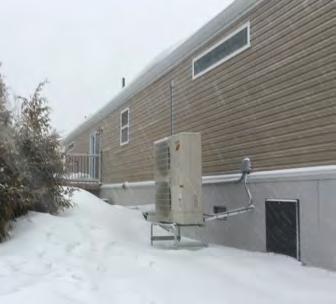
 By Dan Vastyan
By Dan Vastyan
4 HPAC | OCTOBER 2023 HPACMAG.COM
TERRA MECHANICAL 16 30
PHOTO COURTESY
CONTINUED ON P6
62
OCTOBER 2023 / VOL. 97 NO. 5
CUT THE CORD AND KEEP ON WORKING
Gen-Eye X-POD Plus®

Now you can inspect drain lines far from a power source. The Gen-Pack battery adapter allows up to 12 hours of remote operation with limited access to power. The Gen-Pack is also sold separately.



But wait, there’s more. You can now record onto a ash drive or send the recording to your customers with the built-in Wi-Fi transmitter. Also, you can track just how far the camera has traveled down the line with the on-screen distance counter.
For more information, visit www.drainbrain.com/XPodPlus, or call the Drain Brains ® at 800-245-6200

© 2023 General Wire Spring
(Battery
NEW Gen-Pack™ Battery Adapter.
not included)
ALSO INSIDE:
38 CIPHEX PREVIEW
• Dates and Times
• Seminars & Workshops
• New Product Showcase
• MAP
• Exhibitor Listings
52 EVENT REVIEW
HRAI CONFERENCE SCORES IN MONTREAL!
The annual conference for the Heating, Refrigeration and Air Conditioning Institute of Canada pulled off its hockey theme with a win.
 By HPAC Staff
By HPAC Staff
58
PLUMBING
LEVINE BROS PLUMBING: 100 THANK YOUS!
In celebrating its centennial, Montrealarea plumbing company gives back to its community.
 By Luc Boiley
By Luc Boiley
62 HVAC
LIVING WITH A COLD CLIMATE HEAT PUMP





Despite challenges that may occur with future electrical demand, today’s heat pump technology is up to the task for this Canadian homeowner.
By Ian McTeer
68 HVAC CREATING HEALTHY BUILDINGS
Upgrading commercial HVAC systems with energy recovery ventilation (ERV) and dedicated outdoor air systems (DOAS) makes outdoor air affordable.
 By Nick Agopian
By Nick Agopian
72 REFRIGERATION SUPERMARKET COMPRESSOR REPLACEMENTS
Maintenance and best practices to prevent premature failure.

 By Dave Demma
By Dave Demma
76
MANAGEMENT
MAKE PURCHASING GREAT AGAIN
How to streamline your processes and free up your time.
By Mathew Pottins
6 HPAC | OCTOBER 2023 HPACMAG.COM DEPARTMENTS 8 UPFRONT 10 INDUSTRY NEWS 12 NEWS FEATURE Report promotes Canadian shift from AC to heat pumps. 52 MECHANICAL SUPPLY NEWS 56 PEOPLE 77 THE SOURCE 78 CALENDAR
OCTOBER 2023 / VOL. 97 NO. 5
58 52 CONTENTS


NEXT GENERATION GARBERATORS™ FOR THE PRO GRIND FEARLESS. EZ Connect Disposers Simplified Hardwire and Outlet Connections Up to 4 stages of MultiGrind® Technology Featuring 2 levels of SoundSeal® Technology Dura-Drive® Induction Motor New EZ install features that save you time and money ®/TM © 2023 InSinkErator. All rights reserved. COMING TO CANADA JANUARY 2024
WILLING AND ABLE
FOR YEARS THE MECHANICAL INDUSTRY AND ALL LEVELS OF GOVERNMENT HAVE FORESEEN THE SIGNIFICANT GAP THAT EXISTS between our aging skilled trade workforce and the next influx of workers.
Governments have commissioned reviews, and still there seems to be nothing but questions about where the next generation of skilled workers are going to come from. Most recently, federal and provincial governments are trying to encourage skilled trades people from around the world to relocate to Canada. To be realistic, as a country, we need to understand that the lack of workers is not a Canada-only problem, it’s an everywhere problem.
So, for every immigrant who comes to our country to fill a skilled worker gap, a greater void is created wherever they came from.
There are also attempts to attract non-traditional local citizens to the trades. The top of that list has been women. It’s true, the plumbing and mechanical trades have not always been seen as a path for women, but I have to admit, I do feel that tide is shifting. Of course, I’m not seeing women behind the wheel of every contractor van on the road, but I am seeing more representation at trade shows and construction sites I walk past. That’s promising.
And finally, schools are expanding access and creating more awareness of the trades to students at younger ages. I’m seeing that more and more.
One category that I really hadn’t heard about, or honestly considered, until the recent HRAI conference in Montreal, was people with disabilities.
Mark Wafer, an entrepreneur who owned 14 Tim Hortons restaurants in Toronto, is a successful businessman who also happens to be deaf. Wafer is an expert on the economics of inclusion and consults to governments.
He speaks from experience. His business was known for its hiring practices, having employed almost 250 people with disabilities over 25 years.
At the conference Wafer pointed out that roughly one in five people in Canada, aged 15 or greater, has at least one disability, that’s about 6.2 million people. Don’t just think about people in wheelchairs, or missing limbs, this also includes people with hearing, vision, cognitive, walking, or independent living difficulties. It’s a group that can get overlooked, and in many cases feels overlooked, and doesn’t consider itself as eligible for many jobs.
It’s true, the trades require ability and agility for many tasks, it’s physical work and demands focus. But there are roles in mid- to large-size companies that can be accomplished in a shop from a seated position, and there are roles that don’t require excellent hearing or vision.
According to Wafer, the remarkable fact he learned from hiring people with disabilities, was a lower incidence of accidents in the workplace. People with disabilities are always alert to their surroundings and it’s in their nature to operate with care. There was also very low turnover.
Employers need to show that they are open and willing to work with, and accommodate, a worker who may have one or two special needs. Once they do, employers will find a way to fill some of their workplace gaps.
This may not be the solution, but it’s definitely one to consider.
– Doug Picklyk, Editor
Reader Service
Print and digital subscription inquires or changes, please contact Angelita Potal, Customer Service Administrator
Tel: (416) 510-5113 Fax: (416) 510-6875
Email: apotal@annexbusinessmedia.com
Mail: 111 Gordon Baker Rd., Suite 400, Toronto, ON M2H 3R1



EDITOR
ASSOCIATE PUBLISHER NATIONAL ACCOUNTS
ACCOUNT COORDINATOR
AUDIENCE DEVELOPMENT MANAGER
MEDIA DESIGNER
PUBLISHER
PRESIDENT/COO
Doug Picklyk (416) 510-5218 dpicklyk@hpacmag.com
David Skene (416) 510-6884 dskene@hpacmag.com
Amanda McCracken (647) 628-3610 amccracken@hpacmag.com
Kim Rossiter (416) 510-6794 krossiter@hpacmag.com
Urszula Grzyb (416) 510-5180 ugrzyb@annexbusinessmedia.com
Emily Sun esun@annexbusinessmedia.com
Peter Leonard (416) 510-6847 pleonard@hpacmag.com
Scott Jamieson sjamieson@annexbusinessmedia.com
PUBLICATIONS MAIL AGREEMENT NO. 40065710
Heating Plumbing Air Conditioning (established 1925) is published 7 times per year by Annex Publishing & Printing Inc. HPAC Magazine is the leading Canadian business publication for the owner/manager of mechanical contracting businesses and their supply partners.
ISSN: 0017-9418 (Print)
ISSN 2371-8536 (Online)
Contents Copyright © 2023 by Annex Publishing & Printing Inc. may not be reprinted without permission.
SUBSCRIBER SERVICES:
To subscribe, renew your subscription or to change your address or information please visit us at www.hpacmag.com.
Subscription Price per year: $44.00 (plus tax) CDN; Outside Canada per year: $112.00 US; Elsewhere: 1 year $123.00 (CDN); Single copy Canada: $5.00 CDN. Heating Plumbing Air Conditioning is published 7 times per year except for occasional combined, expanded or premium issues, which count as two subscription issues.
MAIL PREFERENCES: From time to time we make our subscription list available to select companies and organizations whose product or service may interest you. If you do not wish your contact information to be made available, please contact us via one of the following methods: Tel: 416-442-5600 ext. 3552, Fax: 416-510-6875 or 416442-2191; E-mail: blao@annexbusinessmedia.com; or by mail: 111 Gordon Baker Rd., Suite 400, Toronto ON M2H 3R1
Annex Privacy Officer Privacy@annexbusinessmedia.com
Tel: 800-668-2374
HPAC Magazine receives unsolicited materials (including letters to the editor, press releases, promotional items and images) from time to time. HPAC Magazine, its affiliates and assignees may use, reproduce, publish, re-publish, distribute, store and archive such unsolicited submissions in whole or in part in any form or medium whatsoever, without compensation of any sort.
NOTICE: HPAC Magazine, Annex Publishing & Printing Inc., their staff, officers, directors and shareholders (hence known as the “Publisher”) assume no liability, obligations, or responsibility for claims arising from advertised products. The Publisher also reserves the right to limit liability for editorial errors, omissions and oversights to a printed correction in a subsequent issue. HPAC Magazine’s editorial is written for management level mechanical industry personnel who have documented training in the mechanical fields in which they work. Manufacturers’ printed instructions, datasheets and notices always take precedence to published editorial statements.
Proud member of: www.hpacmag.com
8 HPAC | OCTOBER 2023 HPACMAG.COM < UPFRONT
Tear out that wasteful tank and boiler mess...
Navien NCB-H combi-boilers


Unmatched heating and DHW performance, all in one compact unit
• Heating up to 150,000 BTU/h and DHW up to 210,000 BTU/h
• Up to 80% smaller than floor standing boiler and tank water heater
• Optimized DHW priority with mixing valve and water adjustment valve to provide consistent DHW temperatures and industry leading flow rates
• Dual stainless steel heat exchangers for heating and separate SS heat exchanger for DHW
• Built-in controls for 3 zone pumps or 3 zone valves
• Heating TDR up to 11:1 and DHW TDR is 15:1
To learn more about the best-selling combi-boilers in North America, visit navieninc.com.
THE LEADER IN CONDENSING TECHNOLOGY
...and hang up the breakthrough in high capacity combis
CENTENNIAL COLLEGE OPENING ITS NEW ZERO CARBON BUILDING
Centennial College is opening the doors to the first combined LEED Gold, zero carbon and mass timber higher-education building in Canada.
The school’s new A-Building, formerly known as A-Block, establishes a new landmark to Centennial’s Scarborough Campus. Expanding on an existing site, the building spans six storeys and more than 130,000 sq. ft.
An Indigenous Working Group made contributions to Indigenous elements of the build as the College worked with Colliers Project Leaders, EllisDon Construction, DIALOG and Smoke Architecture to deliver the approximately $112-million project that supports Indigenous ways of being and teaching.
The A-Building has achieved zero carbon certification due to its efficient building envelope, along with all-electric domestic hot water heating and HVAC systems.
The building uses air source heat pumps and solar thermal panels to provide heating, cooling and domestic water. The design also includes the use of an electric boiler and electric domestic hot water heater. The mechanical contractor on the project was Plan Group.
A solar photovoltaic panel array on the building's rooftop will generate enough electricity to offset the facility’s electricity use by 68,000 kilowatt hours annually, which will contribute to its LEED Gold certification.
centennialcollege.ca

ICC UNVEILS 2024 INTERNATIONAL PLUMBING AND MECHANICAL CODES
The International Code Council, the leading global source of model codes and standards and building safety solutions referenced around the world, has announced the release of the 2024 International Plumbing Code (IPC) and the 2024 International Mechanical Code (IMC) from the forthcoming 2024 editions of the International Codes (I-Codes).

The council says the 2024 IPC and IMC will be the first codes among the 2024 I-Codes to undergo substantial formatting changes to improve the user experience and better align print and PDF versions of the I-Codes with the Code Council’s Digital Codes content.
The 2024 IPC improves public health through enhanced waste management requirements and plumbing system resilience to natural hazards.
It also advances community sustainability through new water conservation measures, while assuring building accessibility through the integration of the updated ICC A117.1 Accessibility Standard, making the IPC the most comprehensive plumbing code available.
Some of the updates to the 2024 IPC include:
Provisions added for support of buried piping beneath buildings where expansive soil conditions exist.
Option added for vacuum testing of Drain Waste Vent (DWV) piping. Showerhead flow limited to 2.0 gallons per minute (gpm) with performance complying with high efficiency requirements.
Standards added for chemical waste piping and fitting materials.
The 2024 IMC establishes minimum regulations for mechanical systems using prescriptive and performance-related provisions.
Important changes from the 2021 IMC include:
Requirements prohibiting the use of domestic ductless range hoods in Groups I-1 and I-2 were removed.
Group A2L and B2L refrigerant requirements have been added.
Leak detection monitoring with alarm requirements have been added where the discharge from safety relief valves is not “readily visible” to occupants.
Outside air requirements for dwelling units have increased.
Requirements for exhaust system common ducts serving separate dwelling units have been added requiring the common duct or shaft to be maintained at a negative pressure at all times.
The 2024 IPC and IMC are the first I-Codes to align with the Code Council’s Digital Codes content, which will be implemented within the 2024 I-Codes and all future I-Codes, all aiming to improve user experience with a modern look that improves readability. iccsafe.org
10 HPAC | OCTOBER 2023 HPACMAG.COM INDUSTRY NEWS
SEE THE LATEST NEWS @ HPACMAG.COM Continued on p12
STAINLESS STEEL
PIPE VALVES FITTINGS HANGERS
304 SS / 316 SS
Available in sizes 1/2” - 24”
Sch.10, Standard and Extra Heavy pipe, weld fi�ngs and flanges available

Small fi�ngs available in threaded or socket-weld
Valves include, balls, gates, globes, checks and knife gates (various end connec�ons)

Material IN STOCK!

www.flocor.ca
REPORT PROMOTES CANADIAN SHIFT FROM AIR CONDITIONERS TO HEAT PUMPS
Installing heat pumps instead of central air conditioners is a rare “win-win” opportunity, states a new report that promotes a rapid transition away from central air conditioning units to heat pumps across Canada.
The report, The Cool Way to Heat Homes: installing heat pumps instead of air conditioners in Canada, was developed by the Building Decarbonization Alliance, Canadian Climate Institute, Efficiency Canada, and Greenhouse Institute.

The report notes that nearly 7,000 Canadian households install a central air conditioner every week, and suggests they could have installed a heat pump instead, adding that “for many people this isn’t a conscious choice: many don’t realize there’s an alternative, and a “heat pump” doesn’t sound like something you’d buy to cool your home.”
The lack of awareness was apparent in 2022, as it reports that Canadians bought 36,000 new ducted heat pumps in 2022, but they also bought 10 times as many central air conditioners.
The authors of the report say that swapping air conditioner installations with heat pumps would save Canadians $10.4 billion in energy bills and cut the country’s emissions by 19.6 million tonnes of CO2 equivalents, producing what they lay out as $12.6 billion in net benefits.
According to the report, improvements in heat pump technology is making the transition more affordable. The report's authors note: “Traditionally heat pump performance declined when temperatures got really cold. But now there are
specialized “cold-climate” models that can maintain their full heating capacity down to -15C, and can still operate effectively down to -25C. Cold-climate performance is no longer confined to expensive high-end units either. There are increasing numbers of “mid-range” cold-climate models available whose costs are not far above that of non-cold climate units. When combined with existing rebates, these units can even be cheaper than single-speed alternatives.”
Adrian Steel ladder racks are designed to make loading and unloading ladders easier and more ergonomic, but their most important function is helping you make it safely home at the end of each day.

ProLiftTM elevates safety by lifting ladders with unique, patent-pending mechanical advantages and dampers. Ladders can be raised and lowered effortlessly. Requiring up to 50% less effort from you to do the job, ProLiftTM helps reduce back and shoulder injuries. With Adrian Steel, ladders stay put and you stay safe, it’s as simple as that. Learn more about ProLiftTM and our ProfileTM rack system at adriansteel.com
As for impacts across the supply chain, the authors suggest manufacturers can make the switch to heat pumps from air conditioners with little cost difference, distributors can streamline inventory by reducing their AC line-up, and for contractors: “Selling and installing heat pumps is not vastly different from selling and installing central air conditioners. But the change does require additional training, and contractors need to prepare to help consumers navigate incentive programs and use their new HVAC systems. As long as sales of central air conditioners outpace those of comparable heat pumps, contractors have less incentive to commit to selling heat pumps. A market transformation strategy would provide an incentive to build familiarity with heat pumps, and certainty that investing in appropriate training and sales processes is worthwhile.”
The report closes with proposals for governments to expedite the transition. Of note, it suggests that “Canada is facing a deficit of workers in skilled trades, including HVAC installation and repair. Governments can do more to support training more HVAC contractors to ensure households can get heat pumps installed quickly and properly.” transitionaccelerator.ca
12 HPAC | OCTOBER 2023 HPACMAG.COM
from p12
Continued
< INDUSTRY NEWS
HPAC_AdrianSteel_Oct23.indd 1 2023-09-18 8:58 AM
Continued on p14
Take Your Time Back With American Standard
American Standard values your time. Our Flash™ Shower Rough-In Valves are built to install quickly and easily into a variety of work spaces. From tight spaces to thin wall applications— and everything in between—the Flash™ Shower Rough-In Valve has you covered. Because in your business, time is money.
Learn More at americanstandard.ca/flash

ENERCARE ENTERS B.C.
Enercare Inc., the large home and commercial HVAC services company owned by Brookfield Infrastructure, has announced a strategic investment in Pioneer Plumbing and Heating, one of the longest-running full-service residential and commercial plumbing and HVAC providers based in Vancouver.
This marks Enercare’s first expansion into B.C.
Established in 1976, Pioneer will continue to operate under the same name, with existing leadership and approximately 45 employees..
Enercare, headquartered in Markham, Ont., has existing operations in Alberta, Manitoba, New Brunswick, Ontario, Quebec and Saskatchewan under its Enercare, Service Experts or HydroSolution brands.
enercare.ca
UL 60335-2-40 RECERTIFICATION
The biggest change to the HVAC industry is recertification to UL 60335-2-40. Intertek can help manufacturers during the transition period. Contact our experts today!

FOR MORE INFORMATION
+1 800 WORLDLAB (967 5352)
icenter@intertek.com
Intertek.com/HVACR
ZERO CARBON OFFICE TOWER OPENS IN VANCOUVER
The Stack is the first office tower to attain the Canada Green Building Council’s Zero Carbon Building – Design standard certification and the first high-rise commercial tower in North America built to zero carbon standards.
Co-owned by Oxford and CPP, The Stack is a 37-storey, AAA-class 550,000 sq. ft. office tower in downtown Vancouver, the city’s tallest commercial building.

The tower’s twisting stacked box design was conceived by Vancouver-based architect James K.M. Cheng.
Its Zero Carbon strategy included a tight building envelope using a tripleglazed curtain wall with enhanced air tightness to reduce its energy demand
along with its electrified heating/cooling system design using air source heat pumps with heat recovery.
In addition the tower has on-site renewable energy through a rooftop photovoltaic solar panel array that will generate 26,000kWh of energy annually.
The Stack also deploys smart building technology to provide insights on energy management, optimize building performance and enable preventative maintenance.
thestackyvr.com
VANCOUVER'S ZERO CARBON FIRE HALL PROJECT COMPLETE
Canada’s first zero-carbon firehall is now open. Vancouver initially announced the project back in 2018. The city’s Firehall 17 was constructed to a zero emissions standard and achieved LEED Gold certification and Net Zero Energy. It is also on track to be Passive House certifed.
The original hall was constructed in 1954, and the rebuild was completed in the spring of 2022. Introba (formerly Integral Group) led the mechanical engineering and design, which includes a geo-exchange field coupled with ground source heat pumps for the heating and cooling water throughout the building. The overall gross floor area is approximately 22,000 sq. ft.
According to Introba, the “high-performance building envelope allows the geoexchange field to be a fifth of the size compared to an equivalent building built to minimum code standards.”
Design also includes efficient air, heat and water recovery systems including high-performance HRV, and an on-site solar PV array that can allow the all-electric fire hall to remain operationally resilient in the wake of a disaster.
vancouver.ca
14 HPAC | OCTOBER 2023 HPACMAG.COM
Continued from p14
HPAC_Intertek_Oct23.indd 1 2023-09-07 9:03 AM < INDUSTRY NEWS
The Cleaner Way to Heat
Aegis
® Electric, CO2 Heat Pump Water Heaters
Global Warming Potential of 1.0
Aegis commercial heat pump water heaters use electricity and natural, non-toxic CO2 (R744) refrigerant to produce domestic hot water up to 170°F all year round with no need for supplemental heat.
Available in air and water sources, as well as a unique hybrid air source with cool recovery, The Aegis is one of the cleanest, most efficient and environmentally friendly ways to heat domestic water. Learn more at lyncbywatts.com.



817.335.9531 | lyncbywatts.com/aegis
SWEET HEAT 2023
The third annual HPAC Magazine Sweet Heat Awards celebrate excellence in residential and commercial hydronics installations.
BY DOUG PICKLYK
In the early Spring of 2023 HPAC Magazine sent out the call for hydronics industry contractors across Canada to enter the third annual Sweet Heat Installation contest, a competition for contractors to share photos, explain the challenges they encountered and the creative solutions they used on projects completed in the past year.

In total, this year’s competition received 19 entries, and like past editions of the Sweet Heat contest, the entries were divided into two categories: commercial and residential.
Once again this year, the competition was generously sponsored by EMCO, the nationwide wholesaler, with the winning entry in each category receiving $3,000 vouchers at their local EMCO branch.
For 2023, the final evaluations were performed by three judges. Hydronics expert John Seigenthaler who brings over 40 years of industry experience to the role. Robert Bean, a long-time industry veteran from Western Canada who consults internationally, and Jeff House, a specialized veteran in the hydronics field providing sales, consulting, training, design, and hands-on jobsite instruction across Canada since 1991.
Bean was also a judge for the first Sweet Heat contest in 2021, and upon reviewing the entries his criteria for success include technical and installation challenges overcome as well as simplicity and purpose of design.
“Whenever I look at a new install or retrofit, I’m looking at the utility of the system from a perspective of usefulness and completeness. I’m also look-
ing at the challenges versus the effort that went into simplifying the design and fabrication,” says Bean.
“These are the guiding light questions I use to evaluate a system: What was done to preserve and conserve materials, labour and energy? What steps were taken to minimize entropy (reduce wasted heat)? How does the system promote indoor environmental quality, energy and exergy efficiency?”
Of note, this year’s winner in both categories use heat pumps as the primary heat source for the buildings. This is the first time this has ever happened in the contest.
The winners were first revealed live
during the final session of the 2023 Modern Hydronics Summit, held at the Hard Rock Casino in Coquitlam, B.C. on September 21.
TERRA MECHANICAL
This year’s winner in the residential category went to Terra Mechanical for the installation of heating and cooling in a massive 36,000 sq. ft. monster home in the exclusive Point Grey community in Vancouver.
Among the challenges of designing and completing this project was making everything fit within a tight two-level mechanical room and accommodating the
Continued on p18
16 HPAC | OCTOBER 2023 HPACMAG.COM
PHOTO: TERRA MECHANICAL
< SWEET HEAT
The winning residential hydronic installation was a project by Terra Mechanical of Vancouver in a 36,000 sq. ft. custom home incorporating geothermal heat pumps and using BIM modelling to design the mechanical room.
Are you ready for the next step in circulator pumps?


 Model: UPSe 15-58F P/N: 92603106
DIGITAL ALPHA
Model: ALPHA 15-58F P/N: 92603115
Model: UPSe 15-58F P/N: 92603106
DIGITAL ALPHA
Model: ALPHA 15-58F P/N: 92603115
Grundfos.to/HPAC2023
32 zones of control, notes Jason De Los Santos, co-owner of Terra Mechanical along with John Rosse.
The company has been in business since 2003 and has found a niche focusing on energy efficiency and working on high-end architectural homes.
The winning entry is a custom home, built by Kindred Construction of Vancouver, that includes in-floor radiant heating (supply temperature is 90F), pool and spa heating, domestic hot water, snow melt, hydronic make-up air and two large heated Koi ponds.
Because of Vancouver’s strict electrification rules for new builds, the home has 40 tons of geothermal. Its primary heating is supplied by four water-to-water heat pumps with three electric boilers (250,000 Btu/h) as back-up. There is also water-to-water heat pump supplying the domestic.
The main cooling for the house is supplied using a water-to-refrigerant sys -

tem, but there is also water-to-water to supply four chilled-water fan coils in the lower basement for cooling.
“Originally the whole project was to be water-to-refrigerant with 30 fan coils throughout the house for the cooling, but when we were installing everything the basement ceilings ended up being way too low,” says De Los Santos.
So, they had to redesign that area moving to chilled water, adding another heat pump and using wall mounted instead of ceiling mounted fan coils.
This custom home is the second project where the Terra Mechanical team used BIM modelling to ensure every component and piece of pipe would fit and integrate into the tight mechanical rooms. Working with Rodrigo Freig of
Modelo Tech Studio, the team used a laser scanner to measure the spaces and a BIM model was finalized and a CAD file sent off to aquatherm for pre-fabrication of the piping spools.
“This was a perfect project to use the BIM modelling because of the scale of the project and cost-wise it made sense,” says De Los Santos. “Otherwise, we would have been inside that mechanical room for two years.”
He estimates that Aquatherm prefabricated about 60% of the piping, and then Terra Mechanical was able to fuse all the spools together on site.
“While a 36,000 sq. ft. house is obviously a challenge equal to or exceeding a commercial project, I liked the preplanning and use of BIM for fabrication
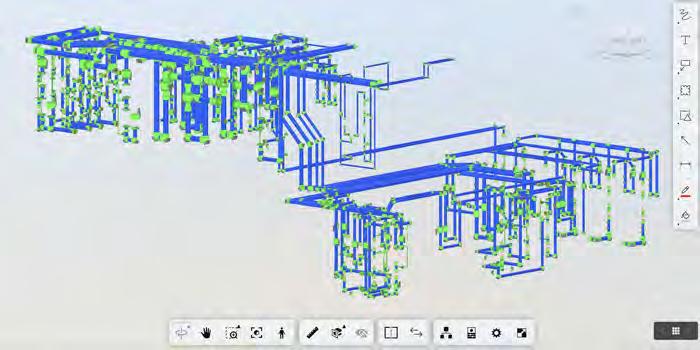
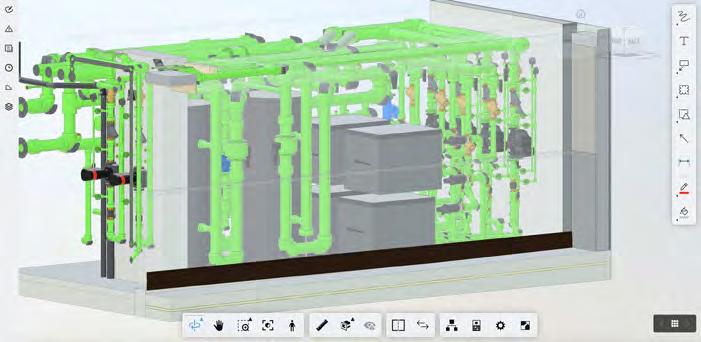
18 HPAC | OCTOBER 2023 HPACMAG.COM Continued from p18
< SWEET HEAT
The winning residential project has 32 zones, and one of the judges appreciated that the controls were well separated from the wet components in the mechanical room.
From BIM files Terra Mechanical was able to ensure everything would fit in the mechanical room.
Once the digital modelling was complete files were sent to aquatherm to have piping spools prefabricated.
PHOTOS COURTESY TERRA MECHANICAL
of piping spools prior to installation,” notes judge, John Siegenthaler.
He also liked the organization of placing the controls away from the wet components. And as noted, there are 32 zones in the project, and the controls were also integrated with the home’s automation system.
PRESTIGE MECHANICAL
The winning company in the commercial category is Prestige Mechanical of Barrie, Ont. for a project that included the installation of two large air-to-water heat pumps on the roof of an existing condo building in downtown Toronto.
Prestige was the prime contractor for this mechanical project which included the first Canadian installation of air-towater heat pumps from Climaveneta, a brand of Mitsubishi Electric. To replace an existing 110-ton air-cooled chiller

that had reached its end of life, two heat pumps were required, a 55-ton unit and an additional 65-ton heat pump unit. Along with hooking up the massive commercial units, Prestige needed to fabricate structural supports on the rooftop for the larger unit and arrange the crane day to both remove the retired chiller and haul up the two new heat pumps.
Prestige Mechanical was started by Glenn Welch in 1994 in Toronto, and in 2008 he moved the head office about an hour north up to Barrie, Ont. The majority of the company’s work continues to be in the Greater Toronto Area specializing in high-rise residential, providing service and performing retrofits like boiler, chiller and make-up air replacements. So, this project was a great fit for the Prestige team.
The small penthouse mechanical room on the building, measuring around

400 sq. ft., distributes the domestic hot water as well as the hydronic heating and cooling to the in-suite fan coil systems for the 160 units at the two connected 10-storey condo buildings.
“The biggest challenge with this project was actually the logistics—it was a very small mechanical room in the penthouse,” says Bradley Welch, estimator with Prestige. “A lot of thought and planning went into different ways to support and mount equipment and piping while keeping floor space for walkways and paths for serviceability.”
The system design was developed by Mark Greenhill, P.Eng., of Remy Consulting Engineers, who was brought in by the condo board when it was determined that heat pumps was the way to go.
Fitting all of the required piping in the penthouse mechanical room required
HPACMAG.COM OCTOBER 2023 | HPAC 19
HPAC_VelocityBoiler_Oct23.indd 1 2023-09-13 1:32 PM
multiple site visits and collaboration among the engineers and the Prestige team to make it all fit and be serviceable, notes Welch.
First, the Prestige team demolished an old atmospheric boiler along with all the piping to and from the retired chiller. The condo buildings run on a two-pipe system, so previously there was a switch over between heating season (boilers) and cooling season (chiller)—not anymore.
Each heat pump requires its own closed-loop circuit with a buffer tank, expansion tank and circulating pump. The heat pump loops are filled with a 40% glycol solution which runs outside to the heat pumps and ultimately supplies heating (or cooling) via brazed plate heat exchangers to the primary water-filled loop in the mechanical room.
The primary circuit then connects to the secondary distribution loop which supplies the heating/cooling water to the fan coils throughout the building.
A new building automation system (BAS) controls the staging of the two heat pump units, and based on outside temperatures the BAS also controls
when the remaining boiler will kick in to supply heating when the temperature drops below a set cut off for the heat pumps.
Prestige enlisted Sam van Berkel, P. Eng., of Watershed Technologies, who assisted greatly in setting up the controls. “He’s the brains behind the building automation system,” says Welch, who adds that the project really required a team effort among all the engineers, the team at Mitsubishi and Prestige.
From the judges’ perspective, this project was a great example of “modern” hydronics and it was a unanimous selection for the top prize. “I liked the preplanning to fit into the tight mechanical room while still providing good access to major equipment,” noted Siegenthaler. He also liked the integration of air-to-water heat pumps and boiler with staging relative to outdoor temperatures.
RUNNERS UP
The runners up in this year’s contest included Canuck Mechanical of Prince George, B.C. (commercial) and Aqua Plumbing and Heating of Edmonton (residential).
The Canuck Mechanical project involved the replacement of an old atmospheric boiler in an apartment building.
2023 SWEET HEAT ENTRIES
The replacement included the installation of two wall-hung modern condensing boilers and using side-wall venting. The new system now adds redundancy and Canuck also added an indirect hot water tank to boost capacity. All of the work was also done in a way the minimized any disruption to the tenants.
The job by Aqua was in a new large 2,800 sq. ft. bungalow in Sturgeon County. The customer wanted multiple zones, including many micro zones. The contractor also had to re-use existing boilers which were oversized. The design uses a buffer tank to provide volume for longer boiler run times, and an indirect tank provides the DHW. The team installed nearly 9,000 ft. of tubing in the floors and the loop spacing in the floors was carefully calculated. Communicating controls were used to provide zone synchronization and indoor feedback.

All of this year’s entries included great examples of creative hydronic solutions to meet the challenging demands for both residential and commercial customers.
Thank you to everyone who entered, and HPAC Magazine would like to encourage all hydronic system installers across the country to keep photos of their best work and enter next year’s edition of Sweet Heat. <>
Thank you to all of the contractors who entered the third annual Sweet Heat hydronics installation contest:
4J Mechanical, Smoky Lake, Alta; Ace Plumbing & Heating, Kelowna, B.C.; Aqua Plumbing and Heating, Edmonton, Alta.; AquaTemp, Warman, Sask.; Canuck Mechanical, Prince George, B.C.; Donaldson Plumbing & Heating, Inverary, Ont.; John Sadler Plumbing & Heating, Surrey, B.C.; Morrisburg Plumbing and Heating, Morrisburg, Ont.; POC Plumbing & Heating, Coldwater, Ont.; Premier Heating and Cooling, Strathroy, Ont.; Prestige Mechanical, Barrie, Ont.; R.T. Heating and Air Conditioning, Red Deer, Alta.; Schuller Solutions, Stouffville, Ont.; Shuswap Water Services, Salmon Arm, B.C.; Terra Mechanical, Vancouver, B.C.; TJL Mechanical, Fergus, Ont.; Van Custom Plumbing, Delta, B.C.;
20 HPAC | OCTOBER 2023 HPACMAG.COM
PHOTO COURTESY PRESTIGE MECHANICAL.
< SWEET HEAT
Prestige Mechanical was challenged with fitting in the piping for two separate heat pump circuits along with a primary loop and secondary loop in a small space.


800.526.0288 | sales@aerco.com Benchmark® Platinum condensing boiler & SmartPlate® EV indirect water heater Maximizes energy efficiency and reduces peak design load Lowers installation costs - less venting and gas connections required Saves space with ultra-compact footprint Streamlines startup and operation with direct two-way communication between units, enhanced diagnostics and configuration capabilities Boost Efficiency and Savings with AERCO’s Combination Plant Learn more at aerco.com/combination
Air-to-Water Heat Pumps Today
Discussing the fundamentals of the technology and considerations for system design. BY
 HPAC STAFF
HPAC STAFF
The latest installment of HPAC magazine’s 30 Mechanical Minutes, the free webinar series, took place August 23rd and focused on air-to-water heat pumps, how they work, who’s making them and some key installation considerations.

In this episode, HPAC editor Doug Picklyk was joined by regular contributor and hydronics expert John Siegenthaler. This edition was sponsored by Aermec, manufacturers of airto-water heat pumps for commercial and residential applications.
The worldwide push towards decarbonization and electrification is leading the hydronics industry away from gasfired boilers and towards electrically powered heat pumps, both geothermal solutions which can carry a large install cost because of the required geothermal loops, and the more approachable air-to-water heat pumps.
Siegenthaler foresees that air-to-water heat pumps are definitely going to be a growing market across North America, noting that it’s already a very large market globally, with about 4 million a year
going into traditional hydronics markets in Europe and Asia.
In explaining the basics of how air-towater heat pumps operate, Siegenthaler drew the comparison to a ductless mini split, which is a heat pump that absorbs heat from outside air, but instead of blowing air into a building, an air-to-water system distributes that heat through a heat exchanger to a hydronic distribution system.
TWO TYPES
There are a two different ‘flavours’ of air-to-water heat pumps. One style is called a ‘monoblock,’ or a self-contained unit. It is factory charged with refrigerant. “The installer is going to set that on some type of a pad or a mounting frame. They’re going to connect two water pipes to it and an electrical harness, but typically there is no need to adjust the refrigerant charge in it,” explains Siegenthaler.
He suggests that this will probably be the dominant configuration, at least initially, as air-to-water heat pumps gain market share in North America.
In monobloc systems the refrigerant is contained in the outdoor unit and water solution runs from the outdoor unit to inside. As Siegenthaler explains, typically in cold climates most manufacturers are going to insist on using antifreeze in the water, typically a mixture of propylene glycol and water. “If there is a prolonged power outage, and it’s below freezing, any water in an outdoor unit it could freeze and damage the unit.”
The other configuration is a “split’ system, similar to common central air conditioning systems or even a ductless mini split. There is the outdoor unit and an indoor unit connected with refrigerant lines. The refrigerant flows from the outdoor unit through the indoor unit where it transfers heat to water.
He says the installation of this type of system requires some basic refrigeration tools and skills, like knowing how to connect the line set, how to do a pressure test, or how to pull a vacuum.
He listed 10 different brands that manufacture and sell air-to-water heat pumps in North America, either monobloc or split systems, including three
22 HPAC | OCTOBER 2023 HPACMAG.COM < HYDRONICS
Figure 1. Low temperature supply water is the new normal for all heat sources, especially air-to-water heat pumps.
IMAGE: JOHN SIEGENTHALER:
Canadian brands. He also notes five other manufacturers that are anticipated to hit the market soon.
“I do want to stress; there is product availability,” says Siegenthaler. “This is not something we’re waiting for. If you want to go out and install one of these systems tomorrow you have several brands, and within each brand you’ve got different capacity ranges to choose from today.”
He estimates that within the next couple of years we’re going to see more companies getting into the air-to-water
heat pump market with offerings in North America, including brand names more familiar to those in the traditional boiler market and the more traditional furnace market.
COLD CLIMATE CONCERNS
Hydronics pros are concerned about the heating capacity of a heat pump when compared with a gas fired boiler. And Siegenthaler explains, that as it gets colder outside any air source heat pump decreases in its heating output, so the Btu/h it can generate goes down when
you need heat the most.
He presented a graph showing that heating capacity is also a function of the water temperature we require the machine to output. The lower the water temperature the heat pump outputs the higher its heating capacity.
Coefficient of performance, COP, is the ratio of the heat output divided by the power input used to generate that heat. As it gets colder, the COP (or efficiency) goes down, and as the water temperature that the unit is operating at increases, the COP also goes down.
So, for Siegenthaler, the takeaway is that the best performance is going to be with low temperature hydronic distribution systems like radiant slabs, large panel radiators and fan coils that can be sized for temperatures of 120F or less. He uses that number as a typical guideline.


Showing a bar graph (see Figure 1), Continued on p24
www.aermec.us



ANKi 045
REVERSIBLE AIR/WATER HEAT PUMP

Minimum ambient operating conditions of -20°C
Minimum chilled water temperature for cooling of -8°C
Inverter compressor with option of Quick & easy installation inverter pump
HPACMAG.COM OCTOBER 2023 | HPAC 23
Cooling capacity 1.6 - 3.2 ton Heating capacity 20,077 - 40,707 BTU/h Production of hot water up to 60°C
Mits Airconditioning
CONTACT US FOR MORE INFORMATION: Mits Airconditioning Inc., Hydronics Division 6125 Netherhart Rd. Mississauga ON L5T 1G5 1-800-567-2221 x.381 info@mitsair.com HPAC_MITSAir_Oct23.indd 1 2023-09-15 2:16 PM
Inc. is the Master Distributor for Aermec S.p.A. products in North America.
Host Doug Picklyk, editor of HPAC (left), questioned hydronics expert John Siegenthaler about airto-water heat pumps for the residential market.
he displays typical ranges of water temperature for different hydronic heat emitters, and on the left, in the purple, he’s drawn a line at 120F.
From this diagram he shows how several types of radiant systems including floor heating, wall heating, ceiling heating as well as panel radiators can be effective with low temperature water.
Siegenthaler mentioned a job he was involved with last winter that used panel radiators supplied from an air-to-water heat pump. “We’re able to heat the house with 90F water, and it’s because the panel radiators have been sized for those low water temperatures.”
But he also says, “Don’t give up on air-to-water heat pumps even if you have a hydronic baseboard system, because you will still get partial output, and in many climates you can get three quarters or more of the seasonal heating energy from the heat pump.”
RADIANT CEILINGS
He’s also a proponent of non-typical solutions like radiant ceilings and walls. “I would urge people to look at these.”
Using radiant ceilings as an example, he says that at 110F degree average water temperature he can get about 28 Btu/h per sq. ft. “It comes up to temperature quickly, and it’s adaptable to radiant cooling down the road.”
He also showed examples of radiant walls, the same construction principles as the ceilings just turned 90 degrees. “You really don’t see them much, but they’re a little higher output than a radiant ceiling because there is a little bit better convection on a vertical surface.”
And modern panel radiators are also a great option, with several brands available now in North America.
“They can be sized around relatively low water temperatures, I’d say anywhere from 100F to maybe 120F at design load, and they can be equipped with a thermostatic radiator valve, so the
homeowner can have room by room zoning with no batteries, no wires, no apps. Just a very simple little turn of a knob.”
DUAL FUEL
Instead of direct replacements, he foresees a future with homeowners keeping their boilers along with an electric air-towater heat pump.
“Dual fuel has a number of really good points to it, especially if it’s a retrofit,” says Siegenthaler. “If you’re going into a house or commercial building that has a boiler that has some life left in it, don’t tear it out. Use it as the backup and as the supplemental heater.”
“One of the nice things about a fossil fuel boiler is you can run it on a very small generator. So, on the occasion where you have a power outage, while it is possible to run a heat pump on a backup generator, it has to be a fairly large generator. Probably a minimum 5,000-Watt genera-
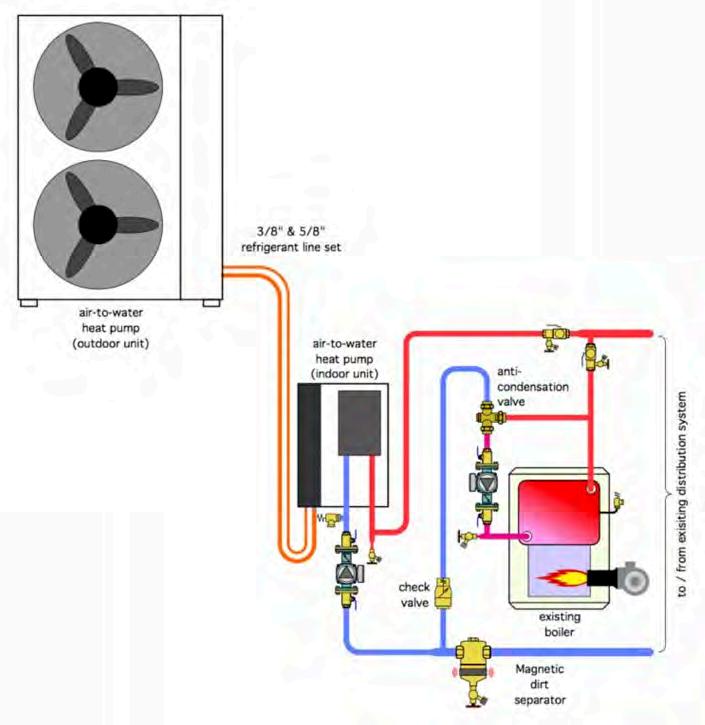
tor on an average house.
“Whereas a boiler, the burner on an oil burner needs about 400 watts of power, and the circulators are low power. So, with a relatively small portable generator you could keep the heat on in the building using the boiler.”
He says another nice thing about dual fuel, is that it sets up scenarios favourable to both electric utilities and customers. “Think about off peak rates where the heat pump could operate on the lowest cost electricity, and then perhaps the fossil fuel boiler could operate when electricity is at peak price. I think that opens up a lot of possibilities.”
There were many great questions asked by the live audience. To see the entire webinar, visit hpacmag.com/ tech-pulse, and you will also find past editions of 30 Mechanical Minutes. The episodes are also available on the HPAC YouTube channel @hpacmag. <>
24 HPAC | OCTOBER 2023 HPACMAG.COM IMAGE: JOHN SIEGENTHALER::
Continued from p23 < HYDRONICS
Dual fuel: keep the boilers out of necessity.

Visit us at CIPHEX West 2023 Booth #135
CHUMP CHANGE
The low cost of operating a well-designed distribution system is an often-overlooked advantage of hydronics.
BY JOHN SIEGENTHALER
Hydronic heating professionals often promote the concept that current generation modulating and condensing (mod/con) boilers can operate with annual fuel utilization efficiencies (AFUEs) in the range of +/- 95%. And professionals who install geothermal water-to-water heat pumps often boast that their equipment is capable of seasonal average coefficients of performance (COPs) in the range of 3.0 to perhaps 4.0. These performance numbers are possible given the right equipment, the right application, and specific definitions for thermal efficiency and COP.
However, most of those same hydronic pros don’t bother to describe how a well-designed and properly installed hydronic heating system has a distribution efficiency much higher than that of either a forced air system or a system that moves heat through a building using refrigerant (e.g., ductless mini-split heat pumps or VRF systems).

BEYOND THERMAL PERFORMANCE ACRONYMS
For a heating system to truly be best-in-class it needs a high efficiency heat source, and the ability to move heat through a building using minimal amounts of electrical energy.
The latter criteria can be quantified using the concept of distribution efficiency, as defined by Formula 1:

distribution efficiency= rate of heat delivery rate of energy use by distribution equipment
Distribution efficiency has nothing to do with converting electricity or any type of fuel into heat. It has nothing to do with
Continued on p28
26 HPAC | OCTOBER 2023 HPACMAG.COM
w e = 0.4344 × f × ∆ P ncirculator = 0.4344 × 3.0 × 4.60.43() 0.25 = 10.3watt
PHOTO: DEEPBLUE4YOU/GETTY IMAGES
< HYDRONICS
Figure 1. An example of a panel radiator with a thermostatic radiator valve.
AWARD-WINNING

FINALIS
Caleffi’s innovative thermal solution for the control of safe and sanitary domestic hot water combines three main components: LEGIOMIX® digital mixing valve that delivers accurately mixed water temperature and integrates calendar-based thermal disinfection; ThermoSetter™ field adjustable thermal balancing valves that feature a bypass option for disinfection; and SinkMixer™ 4-port anti-scald valves for reliable point-ofuse safety. Approvals include compliance with U.S. and Canadian plumbing codes. CALEFFI GUARANTEED.

www.caleffi.com
LEGIOMIX CONTROL SYSTEM T
2022
the system’s heat source. Instead, it describes how many Btu/hr of heat the distribution system can move from the heat source to the heat emitters for each watt of electrical power supplied to operate that distribution system.
The more heat the distribution system can deliver per watt of electrical power input the higher its distribution efficiency.
To show how wide the gap is between two contemporary systems consider a relatively simple hydronic heating distribution system, using currently available off-the-shelf hardware compared to a forced air distribution system on a state-of-the-art geothermal heat pump.
The hydronic system assumes a building with a design heating load of 30,000 Btu/hr. The building will be heated using eight identical panel radiators measuring 24-in. high by 72-in. long by 4-in. thick. Figure 1 shows an example of one such radiator.
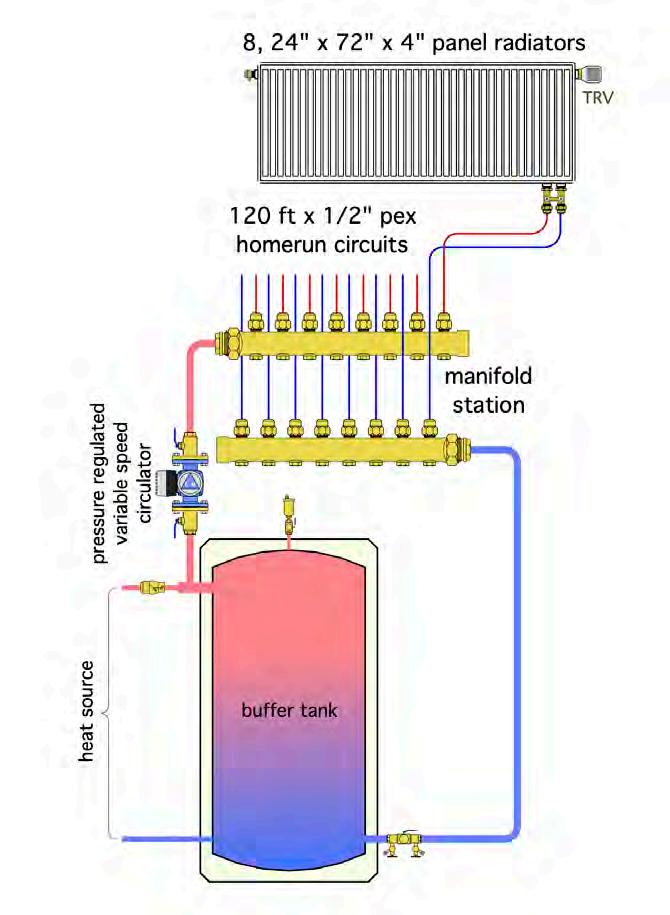
These relatively large panels were selected so the building’s design heating load could be met using an average water temperature of only 110F and a 20F temperature drop (e.g., supply water at 120F and return water at 100F). That temperature makes the system well suited for mod/con boilers, geothermal water-to-water heat pumps, and air-towater heat pumps.
Those eight radiators, operating under these conditions, put out a total of 30,800 Btu/hr, just a bit more than the building’s design load.
The piping for this system is very simple, and it is shown in Figure 2.
The system uses thermostatic radiator valves, which allow each radiator to function as an independent zone. Each room can individually respond to internal heat gains, temperature setbacks, and personal comfort preferences.
Each radiator is connected to a manifold station by 120 feet of ½-in. PEX tubing (60 feet on supply plus 60 feet

28 HPAC | OCTOBER 2023 HPACMAG.COM :
<
Continued from p26
HYDRONICS
Figure 2. The piping diagram for a simple homerun distribution system regardless of heat source.
Figure 3. An example of a low-power modern circulator available today.
on return). The result is a simple homerun distribution system.
A buffer tank is shown between the heat source and distribution system. Its purpose is to prevent heat source short cycling given the relatively low design load combined with a highly zoned distribution system.
From the standpoint of distribution efficiency, the heat source that warms the buffer tank is irrelevant. It’s the hydraulics of the distribution system and those of the variable speed pressure-regulated circulator that matter.
The total system flow rate required to deliver 30,800 Btu/hr with a 20F temperature drop is only 3.1 gallons per minute. This divides up equally among the panels, so each circuit only requires 0.39 gpm.
The combined head loss of the 120 feet of PEX tubing and the panel radiator at this small flow rate is only about 4.2 feet of head. Let’s add another 10% to this head loss to account for some head loss in the short 1-in. piping connecting the manifold station to the buffer tank.
The circulator duty point in this system is therefore 3 gpm at 4.6 feet of head.
PALTRY POWER
The flow rate and head requirement can be used to estimate the electrical power input to a circulator. To be conservative I
distribution efficiency= rate of heat delivery rate of energy use by distribution equipment
assumed a modern ECM circulator with a wire-to-water efficiency of 25% at the calculated duty point.
The estimated electrical input to the circulator can be calculated using Formula 2:
Where:
We = estimated electrical input wattage to circulator (watts)
f = flow rate (gpm)
∆P = pressure differential across the circulator (psi)
Ncirculator = wire-to-water efficiency of circulator (decimal percent)
distribution efficiency =
0.4334 = unit conversion factor
The multiplication of 4.6 x (0.43) represents the head requirement converted to differential pressure (e.g., ∆P), which is necessary to make Formula 2 valid.
If a circulator operated continuously for 24 hours, at this power input, and at a location where electricity costs $0.20 per kWh, the total daily operating cost would be 5 cents!
If the circulator operated continuously throughout a heat season lasting 3,500 hours, at the same input wattage, the to -
Continued on p30
COMFORT DONE RIGHT
Lochinvar has long been an industry leader in commercial boilers—and now we’re bringing that engineering excellence to residential boilers.

The wall mount EPIC® boiler you know and trust is now available in floor standing models.


What Makes EPIC a superior choice?
· Easy To Install, Set Up and Service
· Delivers Hot Water Faster
· Display Screen Uses Text, Not Codes
· Better Technical Support and Training


· 10:1 Turndown Ratio
· Floor and Wall mount available
· Advanced Electronic Control
Lochinvar.com
HPACMAG.COM OCTOBER 2023 | HPAC 29 :
e = 0.4344 × f × ∆ P ncirculator = 0.4344 × 3.0 × 4.60.43() 0.25 = 10.3watt
w
30,800 Btu hr 10.3watt
2990 Btu
hr
=
/
watt
48,000 Btu hr 746 watts
64.3 Btu
hr
distribution efficiency =
=
/
watt
HPAC_AquaTech_Oct23.indd 1 2023-09-08 12:56 PM
HYDRONICS
Continued from p29
tal operating cost would be about $7.30. I suspect that most homeowners could work that into their budget.
w e = 0.4344 × f × ∆ P ncirculator = 0.4344 × 3.0 × 4.60.43() 0.25 = 10.3watt
A few years ago, you would not be able to find a circulator that could operate at such low power. Today there are several circulators on the North American market that can operate in the nominal 10 watt power range. One example is shown in Figure 3.
The inverse of that ratio, 64.3/2990 = 0.0215, or about 2.2%, implies that the hydronic system delivers heat to the building using only about 2.2% of the electrical input power required by the referenced forced air system.
distribution efficiency= rate of heat delivery rate of energy use by distribution equipment w e = 0.4344 × f × ∆ P
Either way you look at it, the hydronic system in this comparison is far more efficient when it comes to delivering, heat.
The distribution efficiency of the example hydronic distribution system can be calculated using Formula 1:
distribution efficiency = 30,800 Btu hr 10.3watt = 2990 Btu / hr watt
= 0.4344 × 3.0 × 4.60.43() 0.25 = 10.3watt

This is not meant as a “put down” on the geothermal heat pump used in the comparison. That heat pump’s thermal efficiency could be excellent (perhaps a COP of 4.0 or more). However, because the heat pump delivers heat using air rather than water its distribution efficiency is very low in comparison to the hydronic system.
A STORY WORTH TELLING
AN INTERESTING COMPARISON
So how does a distribution efficiency of 2,990 Btu/hr/watt rank relative to that of other systems?
distribution efficiency = 48,000 Btu hr 746 watts = 64.3 Btu / hr watt
To put this number in perspective, let’s compare it to the distribution efficiency of a modern geothermal water-to-air heat pump with a variable speed ECM blower motor.
One manufacturer lists the wattage of an ECM blower on a nominal 4-ton (48,000 Btu/hr) rated water-to-air heat pump, at full speed, as 746 watts. Assuming the heat pump delivers 48,000 Btu/hr using 746 watts input to the blower, its distribution efficiency would be:
watts = 64.3 Btu / hr watt
The two calculated distribution efficiencies can be compared by making the numbers into a ratio: 2990/64.3= 46.5. This means that this hydronic system is delivering just over 46 times as much heat to the distribution system, per watt of electrical input energy, compared to the heat pump using forced air distribution.
The concept of high distribution efficiency should be a starting point—rather than an afterthought—when discussing the advantages of a modern hydronic systems. Especially in light of modern low energy and net zero energy buildings, our industry needs to get this message to trade allies like architects and engineers involved with low energy or net-zero buildings, energy auditors, professionals involved in thermally based renewable energy heat sources, and regulators who determine which HVAC technologies are incentivized through government programs.
That’s not going to happen if our industry isn’t proactive. There are lots of technically competent decision makers who have never heard about distribution efficiency. I suspect many of them would embrace the concept based on real comparisons.
It’s time we show them what’s possible. <>
John Siegenthaler, P.E., has over 40 years of experience designing modern hydronic heating systems and is the author of Modern Hydronic Heating (4th edition) and Heating with Renewable Energy (visit hydronicpros.com).

30 HPAC | OCTOBER 2023 HPACMAG.COM
<
rate of energy use by distribution equipment
ncirculator
48,000 Btu hr 746
distribution efficiency = 30,800 Btu hr 10.3watt = 2990 Btu / hr watt distribution efficiency =
Find WHOLESALERS and PRODUCTS here: HPAC’s online BUYER’S GUIDE HPAC_Online BG filler_sept 23_GWJ.indd 1 2023-09-25 11:34 AM
Know What You’re Buying
Not all PEX F1960 Fittings are the Same
If you’ve been told all PEX F1960 cold expansion fittings are the same because they all conform to the same fitting standard, it’s important to understand there are real differences that can make or break your business.
In truth, not all fittings conforming to the ASTM F1960 standard are the same. Manufacturers and suppliers that claim their fittings are compliant to ASTM F1960 feel that, in their opinion, they meet the standard. However, there is no third-party agency to confirm that compliance.
Certification Difference
Uponor ProPEX fittings are a highly engineered product certified by third-party agencies — NSF and the Canadian Standards Association (CSA) — to ensure the raw materials, manufacturing process, and resulting product accurately meet the ASTM F1960 standard.
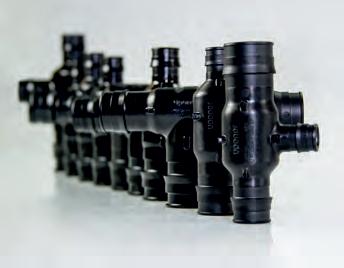
In fact, the companies that mold ProPEX EP fittings are partners that are integrated into the codes, helping ensure the highest-
quality product. ProPEX fittings also undergo internal quality testing that extends beyond the ASTM F1960 standard requirements to provide customers with the strongest value available on the market.
“It’s important that installers are aware they need to ask for the Uponor brand name from distribution and make sure they are getting what they are paying for in ProPEX fittings,” says Bradfield Craig, director of Marketing at Uponor. “The differences are far beyond just the brand name. Uponor testing on generic F1960 fittings has exposed various manufacturing design and quality inconsistencies, and some fittings can’t even pass the ASTM F1960 standard requirements. This is putting projects at considerable risk for failures and potentially voids the associated system warranties.”
Identifying ProPEX
So, how can you tell if you have a real Uponor ProPEX fitting? The easiest way is to look for the Uponor logo. Other indicators
include thicker tube stops and thicker sealing barbs. The thin tube stops on the generic, low-quality F1960 fittings are especially problematic as the expanded PEX pipe can extend past the stops and cause leaks.
If you are purchasing fittings that are not in Uponor packaging and are loose in a bin, be sure to take a close look at each part to ensure you’re getting Uponor ProPEX and not a generic product.
To learn more about the quality and 25-year warranty that accompanies the Uponor system as well as the risks of low-quality F1960 fittings, please visit uponor.com/askforuponor.

ADVERTORIAL
COMBINING TRADITION AND TECHNOLOGY
BY DAN VASTYAN
Hutterites are a branch of Anabaptists, who, like the Amish and Mennonites, trace their North American roots to Europe’s Radical Reformation of the 16th century.
Hutterites have at least two major distinctions from Amish and Mennonites. They live and work in colonies, which function as a large commercial organization. Also, the first Amish and Mennonites in North America settled in the Mid-Atlantic, due the region’s climate, which resembled their homeland in central Europe.
In contrast, when most Hutterites fled Germany and Austria, they first migrated to Eastern Europe before emigrating to North America some 100 years later. They’d grown accustomed to colder climates and searched for similar conditions after crossing the Atlantic. Today, almost all Hutterites live in Western Canada and the upper Great Plains of the U.S.
Hutterite colonies in Canada gener-
ally operate large-scale farming operations. Members, many of whom have mechanical backgrounds, perform their own work and value self-sufficiency, whether that be food production, machinery maintenance or the building trades. Whatever a member’s specialty, rest assured that they’re meticulous, disciplined, trade professionals.
NOT TYPICAL CUSTOMERS
“While Hutterites lead simple lives by choice, it would be a mistake to label their colonies and farming operations as ‘simple’,” says Braden Davie, technical sales representative at AltaTech Agencies in Edmonton.
“In truth, these are sophisticated commercial enterprises that are managed in great detail. While some may assume these colonies are bound to the past, Hutterite communities have their sights firmly set on the future.”
Over the years, Davie and Rob Cox, AltaTech’s owner, have developed a repu-
tation among Alberta’s Hutterite community for providing hydronic insight, concepts, and leading technology. The rep firm, also with a location in Calgary, has been in business since 2005, with an emphasis on plumbing and hydronics.
Another company that’s forged a solid relationship with the Hutterite colonies in Alberta is Mulder Plumbing and Heating. The six-person company in Lethbridge specializes in hydronic troubleshooting and design.

“Our involvement with the Hutterite colonies began several years ago, when we were brought in to diagnose some issues they were having at one of their locations,” says Steve Mulder, company owner.
“These colonies have a lot of skilled manpower, so we work with them as much as they’d like us to, generally for design and technical assistance.”
“Hydronic heat is a key staple for these Hutterite communities,” explains Continued on p34
32 HPAC | OCTOBER 2023 HPACMAG.COM
< PROJECT
ALL PHOTOS: ALTATECH AGENCIES LTD.
The Deep Creek Farms Colony built a 29,000 sq. ft. equipment shop with an adjacent 12,000 sq. ft. wash bay, all with in-slab hydronic heat.
Hutterite Colony in northern Alberta embraces modern hydronics for efficiency and effectiveness.
VITOCROSSAL 300, CA3B
Outstanding versatility, performance and reliability
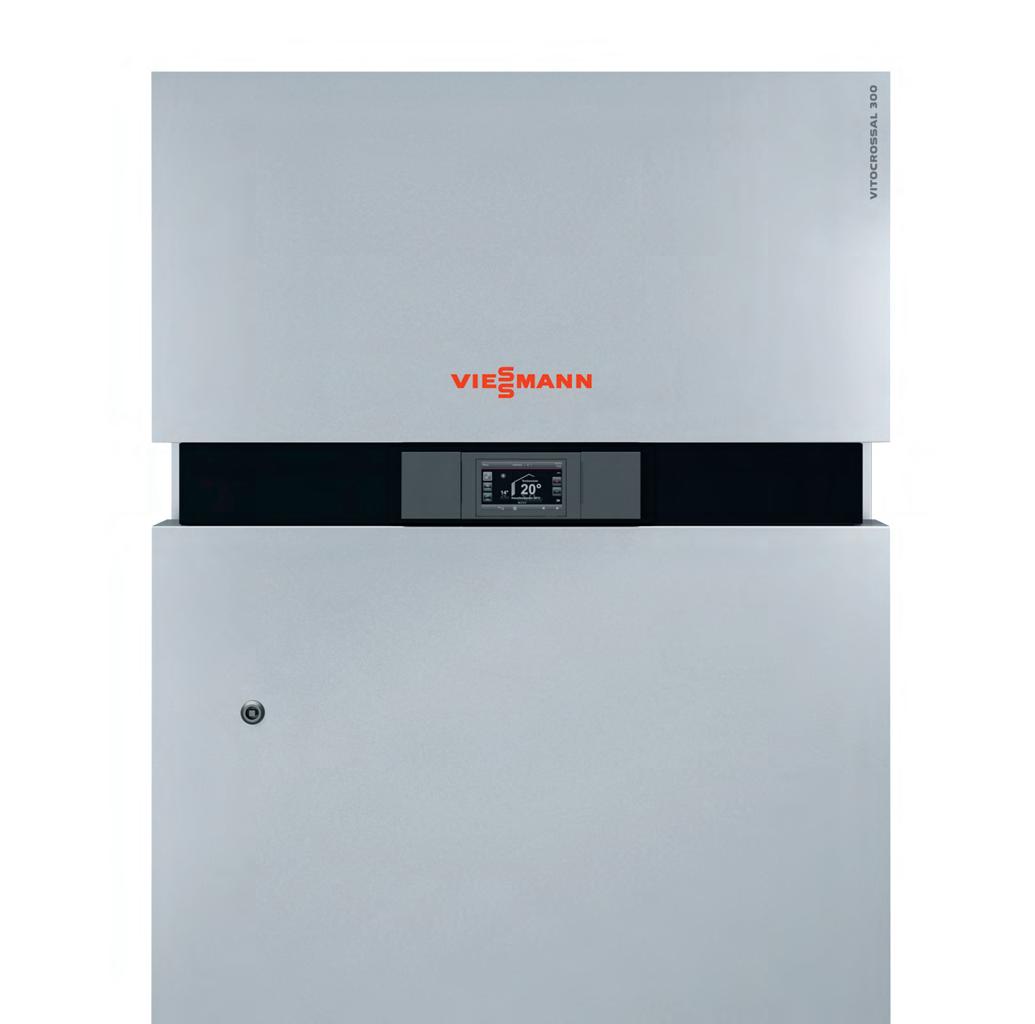
Rated input: 2500 to 6000 MBH

viessmann.ca
Visit us Oct 18-19 at CIPHEX West, Booth #123
Cox. “The colonies in Canada aggressively embraced hydronics when legislation forced them to phase out their central coal plants that used to be the focal point of their communities.”
“We’re glad to have AltaTech in central and Western Canada,” says Sean Giberson, Canadian sales manager, wholesale products, at Taco Comfort Solutions. “They excel at dealing with the Hutterite colonies, and they have learned that it’s not business as usual that most of us have grown accustomed to. Hutterite community members set high expectations and are meticulous and exacting in what they do. Once all their questions have been answered, you can count on a refreshing handshake to seal the deal; demonstrating their sincere belief in the word ‘integrity’.”
UNIQUE LOAD
Leadership at the new, 50,000-acre Deep Creek Farms colony, near Athabasca, located 145 km north of Edmonton, contacted AltaTech and Mulder Plumbing & Heating to discuss several planned construction projects. They were building a new farm equipment shop and also expanding housing for members.
Alberta winters are hard on expensive state-of-the-art agricultural equipment if not properly maintained, so the colony began building a new 29,000 sq.ft. shop with offices and storage space.

Adjacent to that facility, a 12,000 sq.ft. wash bay will also provide the means to keep heavy equipment clean.
Deep Creek Farms planned to build the facilities themselves, but they relied on AltaTech and Mulder for the most technical aspects of the project.
AltaTech made suggestions, provided system concepts, and sourced equipment. While Mulder’s design work included sizing all portions of the systems and creating drawings, in addition to completing some of the most technical installation and commissioning.
The main goal for the heating system – to be installed by the colony’s plumbing team – was that it be robust, longlived and efficient. This included extensive in-slab heating and hot water production for the wash bay.
“One unique element considered was ensuring that the system can overcome the heat lost to the giant trucks and tractors that come in and out of this shop all winter long,” says Davie. “As these giant blocks of frigid steel ma -
chinery act as heat sinks/vacuums every time they get parked inside, we still needed to ensure comfort could be maintained for the users.
“Basically, Mulder confirmed that the boiler plant would be capable of matching the heat load for the facilities plus the additional load of the cold equipment,” he adds. “Because these are modulating systems, we can oversize without concern of short cycling. We also had conversations about how often they’re moving equipment in and out.”
SPECIFIC NEEDS, SPECIFIC PUMPS
The equipment maintenance bays, offices and storage areas are heated exclusively by 10 zones of in-slab radiant operating on outdoor reset. Two additional radiant zones are dedicated to the large wash bay.

In the main mechanical room, four rack-mounted 500,000 Btu/h Viessmann condensing boilers provide all the heat and hot water needed for the facilities.
Continued on p36
34 HPAC | OCTOBER 2023 HPACMAG.COM Continued from p32 < PROJECT
The new shop is used to store and maintain a variety of large trucks and agricultural equipment.
Two of the four cascaded boilers in the mechanical room of the equipment shop. Each of the boilers has a dedicated boiler pump, which allows the installer to adjust the pump’s operating point to exactly match the desired flow rate through the boiler.









Each boiler is circulated to the primary loop by a Taco VR3452 ECM circulator. This pump model is also used to circulate all 12 in-floor zones.
Rather than using a hot water storage to provide adequate volume to the wash bay, stainless steel, plate-and-frame heat exchangers separate the closed boiler loop from the well water used in the wash bays.
“Taco VR3452 circulators were used for the ability to dial in a specific flow rate, which is a great benefit in a cascaded boiler system like this,” explains Davie. “In this manner, we can ensure that all the boilers are seeing the same flow rate and firing at the same input.”
In addition to the large ECM circulators, Taco 0018e circulators were used for zoning. Because this circulator is Bluetooth-programmable, it allowed AltaTech and Mulder to fine-tune the desired flow rate for each radiant zone via the circulator’s mobile app.
SLAUGHTERHOUSE
Adjacent to the shop is a slaughterhouse which provides the community with a place to render all of its own meat, whether for consumption on the property or for sale.
This facility uses two of the same condensing boilers, though slightly lower in capacity and wall mounted, which supply comfort heating as well as heat for processing/sanitizing.
A dual-coil, 120-gallon indirect tank supplies the process water, and the installers roughed in for a second tank to be installed later if needed.
In addition to the space heat zoning in the slab, there is a slab warming zone under the large walk-in freezer. This zone, which operates via a slab sensor, is used during the summer to prohibit frost infiltration of the slab. Running this zone during the warm summer months guards against damage to the slab below the walk-in freezer.
The systems in both buildings use fused polypropylene pipe for all nearboiler and mechanical piping, and each loop has isolation valves for simple service. In most instances, circulators are wall-mounted remotely, instead of inside the mechanical room.

MOVING FORWARD
Once finished, each Hutterite community will accommodate up to about 100 residents. Both AltaTech and Mulder are working with the colony on the residential side of the project. They’re in the process of designing heating systems for the housing complex, which include multiunit four-plex homes, each 8,000 sq. ft. building with its own boiler. In-floor heat and hydronic coils are both used to heat the living spaces, with domestic hot water provided by indirect water heaters.
“The work at new Hutterite communities, like Deep Creek, is never completed all at once as it may be on a typical commercial site,” says Davie, who made numerous trips to the Athabasca site.
“As these communities perform their own work and value self-sufficiency above all else, they tend to follow the schedule of the seasons. This means that they prioritize completing the work
themselves before offering it to others.”
The pace of the work was dictated by the colony’s immediate need and by each seasons’ agricultural activities. When time and circumstances permit, they return to these rooms to complete their technical HVAC tasks, but the seasonal agricultural work takes precedence. This, along with the scale of the project, dictated the pace of the work for Mulder employees, who had to drive six hours from Lethbridge to the colony.
“The focus on serving the larger needs of the community first is quite unique to the culture of Hutterite Colonies, and this stands in stark contrast to the demanding nature of the construction industry where we’re tied to owner schedules and profitability,” notes Davie. “And, as they’re installing their own equipment, and will be responsible for maintaining it, the Hutterites tend to value reliability, durability and service above all else.” <>
Dan Vastyan is president of Common Ground, specializing in marketing communications and serving the North American construction industry with a focus on plumbing, mechanical and HVAC markets. danv@seekcg.com
36 HPAC | OCTOBER 2023 HPACMAG.COM
from
Continued
p34
< PROJECT
The property’s largest mechanical room features a multi-boiler cascade system mounted to the floor in the centre of the room.
Navien takes fire tube technology and performance higher and higher
NFB-H high capacity condensing fire tube boilers
Totally reinvented fire tube technology from the ground up and we continue to advance our compact boiler performance to the highest levels
• Patented stainless steel fire tube heat exchanger—designed to reduce high stress point welds
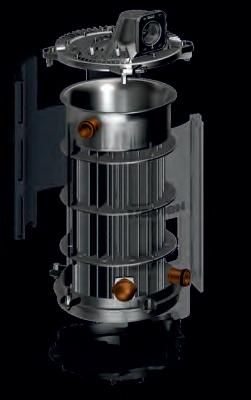
• Advanced user interface with intuitive text display and Quick Dial Wheel
• Smart controls with Setup Wizard to simplify boiler start up and trouble-shooting
• AFUE 95.0%—Energy Star certified
• Compact, light weight, wall hung design saves space over traditional floor standing boilers
• Built-in 3 zone pumps or 3 zone valves powered connections
• Optional NaviLink® Wi-Fi remote control
• Common venting up to 8 units and cascading up to 16 units
• Up to 15:1 turndown ratio
To learn more about the new NFB-H high capacity boilers visit navieninc.com
The leader in condensing technology...does it again.
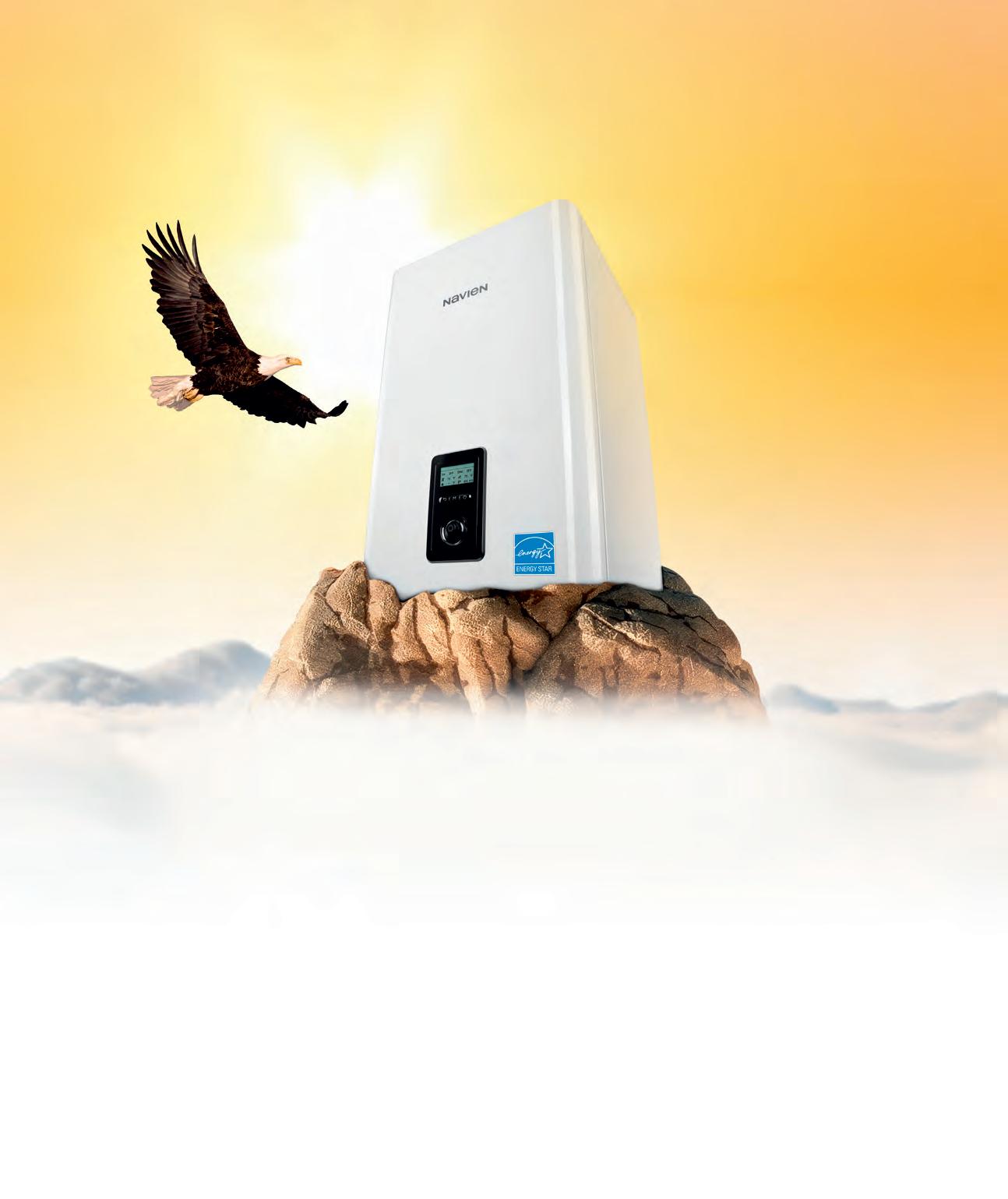
CIPHEX WEST 2023 Preview
BMO Centre at Stampede Park • Calgary, AB
Wednesday, Oct 18 10 a.m. to 6 p.m.
Thursday, Oct19 10 a.m. to 4 p.m.
Western Canada’s largest trade show for the HVAC and plumbing industry returns to Calgary for two days of networking and learning.
Alberta welcomes back the two-day CIPHEX West trade show after a five-year gap since the largest event in Western Canada for the HVAC, plumbing, hydronics and water treatment industries was last held in Calgary back in November of 2018.
The biennial show schedule was interrupted in 2020 due to the pandemic, when it was scheduled to take place in Vancouver. Instead, the west coast event came together in November 2021, and now the two-year cycle is back on track.
This year the trade show is returning to the BMO Centre at Stampede Park, located about 30 minutes
Seminars & Workshops
from the airport, southeast of downtown Calgary. Besides the networking opportunities, the largest draw is to discover new products, possibly new suppliers, and be exposed to new ideas and solutions. Over 160 exhibitors will be on-site this year providing hands-on experiences with tools, parts, appliances and more. In advance of the show HPAC reached out to the exhibitors to find out what products will be featured at their booths, and you will find the new product showcase beginning on page 40. You will also find a map of the show floor and a listing of exhibitors (as of press time in mid-September).
These events take place in the CIPHEX Theatre on the trade show floor.
WEDNESDAY, OCTOBER 18
The State of Net Zero in Canada
Time: 10:15 a.m. - 11:00 a.m.
Presented by Dave Hughes, CIPH
Updates in Reclaimed Water Systems



Time: 11:15 p.m. - 12:00 p.m.
Presented by Kevin Wong, UPONOR
Selecting and Installing Reverse Osmosis Equipment and Evaluating How Water Quality Impacts Pipe Corrosion
Time: 12:15 p.m. - 1:00 p.m.
Presented by Tyler Gamble, Canature Water Group
F.O.G. Fundamentals
Time: 1:00 p.m. - 1:45 p.m.
Presented by Adam Toutant, Canplas Industries
Facts About Acoustics in High-Rise Condos
Time: 2:00 p.m. - 2:45 p.m.
Presented by Cory Norman, IPEX
Air-to-Water Heat Pump Design Considerations


Time: 3:00 p.m. - 3:45 p.m.
Presented by Gary Milligan, TECA
Incorporating Hydronic Heat Pumps into Hybrid Designs

Time: 4:00 p.m. - 4:45 p.m.
Presented by Canadian Hydronics Council

Distributed Pumping – Reducing Energy Use in Pumping Systems by Over 60%
Time: 5:00 p.m. - 5:45 p.m.
Presented by Grundfos
THURSDAY, OCTOBER 19
Innovative Solutions for a New World of Smart Building Performance
Time: 10:15 a.m. - 11:00 a.m.
Presented by Roberto Bosco, Armstrong Fluid Technology
What’s Behind Your Test Kit Results?
Time: 11:15 a.m. - 12:00 p.m.
Presented by Demian Mendez, Arbiter/Cameron Instruments
Heat Pump Water Heaters

Time: 12:15 p.m. - 1:00 p.m.
Presented by Karl Fernandes, Martin Rego, Rheem Canada
Let’s Talk Radon
Time: 1:00 p.m. - 1:45 p.m.
Presented by Fadi Basmaji, IPEX
Integrated Piping System (IPS) the “Affordable Green” Hydronic Heating and Cooling System

Time: 2:00 p.m. - 2:45 p.m.
Presented by Monte Kartchner, Williams
Smart Restrooms for Smart Cities
Time: 3:00 p.m. - 3:45 p.m.
Presented by Bhavik Patel, TOTO (all seminars subject to change)
To access our white paper on “Minimizing Bacterial Loading Using Copper Alloys in Healthcare”
For more information on Copper DefenseTM technology deltafaucet.ca/copper-defense



A unique series of plumbing products featuring an advanced copper alloy finish exhibiting impressive antibacterial properties.




Laboratory testing has shown that when cleaned regularly this surface:
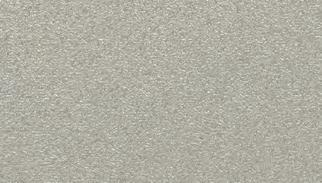
• Reduces bacteria contamination, achieving 99.9% reduction within 2 hours of exposure.

• Delivers continuous and ongoing antibacterial action.
• Helps inhibit the buildup and growth of bacteria within 2 hours of exposure between routine cleaning and sanitizing steps.
FLUSH
VALVES
Clean and sanitize according to standard practice. Healthcare facilities must maintain the product in accordance with infection control guidelines. The use of this surface is a supplement to and not a substitute for standard infection control practices; users must continue to follow all current infection control practices, including those practices related to cleaning and disinfection of environmental surfaces. This surface has been shown to reduce microbial contamination, but does not necessarily prevent cross contamination.
SCAN HERE
1 Vincent, M., R.E. Duval, P. Hartemann, and M. Engels-Deutsch et al, Contact killing and antimicrobial properties of copper, Journal of Applied Microbiology, December 27, 2017; 124:1032—1046. Source of graphics: Drs. Grass, Keevil, Rensing, and Soliaz courtesy of the Copper Development Association CuVerro® and CuVerro ShieldTM are registered trademarks of Wieland North America, Inc. and are used with permission. FAUCETS RETROFIT
KILLS BACTERIA TECHNOLOGY
DEFENSETM © 2023 Masco Canada Limited
New Product Showcase
Bradford White Infiniti GS and GR tankless gas water heaters feature a stainless steel heat exchanger, 11:1 turndown and an output of 5.1 GPM at a 77°F rise and are designed for easy installs with convenient water, gas and vent connections.

The digital Grundfos ALPHA pump features automatic self-venting, dry-run protection and troubleshooting aids with alarm and warning lights. It has a touch interface and can be controlled through Bluetooth connectivity. Its AutoAdapt feature allows easy setup and optimized energy efficiency.
Equipco will show Triangle Tube’s Cardinal indirect water heater tank with stainless steel coil and tank. Available in 30 to 120 gallons, they have 1-in. side boiler connections and top DHW connections.
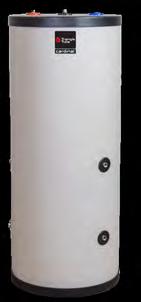
The Fluidmaster PRO45H PRO fill valve with tank and bowl water level control is quiet, powerful and works with all toilet types from 1 gpf to 3.5 gpf, with code approved anti-siphon design.
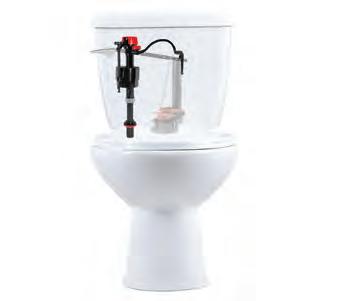

The Calefactio condenSAFE condensate neutralizer is compact and easy to install. Engineered media is contained in a bag that can be replaced without having to disconnect the unit. A 12-month time indicator shows users when to replace the media bag.
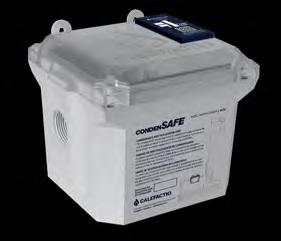

Viessmann’s Vitocrossal 200 CI2 is a floor standing gas condensing boiler with modulating cylinder burner and stainless steel heat exchanger. With six sizes ranging from 399 to 2,000 MBH, this condensing unit can be cascaded for capacities up to 32,000 MBH.

The REHAU EVERLOC+ compressionsleeve fitting system is designed for use with RAUPEX UV shield PEXa pipe in potable water applications. The system features both polymer and lead-free brass fittings in diameters up to 2-in. as well as the EVERLOC+ power tool.
TotalFit is the engineered polymer pushto-connect fitting solution from Uponor. Designed for use with PEX, PE-RT, CPVC, and copper piping systems, it includes 33 fittings in sizes from ½-in. to 1-in. and is approved for use behind walls without access panels.
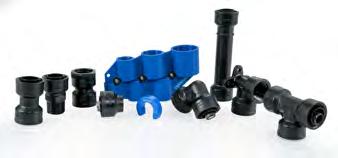

The Resideo Braukmann WiFi Water Leak Shutoff Valve responds to water leaks with an automatic shutoff response. Both the valve and the sensors include a 5-ft cable that senses water along its entire length, with additional devices covering up to 500-ft.

40 HPAC | OCTOBER 2023 HPACMAG.COM
The EZ Flush Sensor retrofit kit from Zurn is a touchless upgrade for a handleoperated water closet or urinal flush valve. Its mechanical manual override button also delivers on-demand flushing. The retrofit kit provides a quick three-minute installation.
Wednesday, Oct 18 10 a.m. to 6 p.m.
pump or in simplex and duplex packaged systems.




Thursday, Oct19 10 a.m. to 4 p.m.

Delta faucets remain durable, leak-free, easy to install, and outlast the industry norm.


Oatey supply lines quickly and easily connect the water supply to fixtures and appliances. Constructed of corrosionresistant material, the connectors bend freely and work with hot or cold water. The lines come in a variety of sizes and connection types.


The Kane residential/commercial combustion analyzer kit with printer includes flue probe, wireless pipe clamp probes, K-type thermocouples, tubing with connectors and more. And when purchased with Kane Care it carries a 10 year warranty with annual recertification.

SpacePak's new Solstice air-to-water heat pump uses R32 refrigerant in a safe monobloc design and provides a solution for heating, cooling, and DHW. The quiet design also offers cold climate heating performance in outdoor temperatures as low as -22F (-30C).

The A.O. Smith Envirosense SF residential gas water heater is a side fired condensing gas tanktype unit featuring continuous water flow with 2.8 gpm @ 65F temperature rise. The ENERGY STAR qualified water heater has a 0.90 UEF rating.
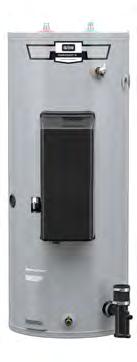
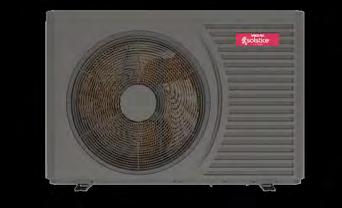
Aqua-Tech will show the Lochinvar EPIC fire tube boiler for residential applications, available in floor or wall mount. The EPIC line-up offers easy installation and serviceability, instantaneous response time and a display using text, not codes.



Franklin Electric’s Little Giant 16G series 1HP grinder pump is designed for high head sewage or effluent removal in challenging residential and light commercial wastewater and clog-prone applications. It’s available as a single

Aalberts’ Apollo SmartPress press system joins ½-in. to 2-in. ASTM A-312 (304/304L and 316/316L) schedule 5/10s stainless steel pipe. The fittings and valves cover applications requiring HNBR, EPDM or FKM sealing elements for pressures up to 500 psi and temperatures to 392F.
Continued on p42

HPACMAG.COM OCTOBER 2023 | HPAC 41
Masco Canada will introduce the Tetra bath collection from Delta including its first faucet with a T-lever handle. Featuring Diamond Seal technology,
New Product Showcase


The new Navien NPF Hydro-furnace is available in upflow and horizontal configurations, in 60,000 and 100,000 Btu/h. The variable capacity NPF can modulate down to 15%. The fully enclosed ultra-low NOx premix burner provides quiet operation and efficiency of 97% AFUE.


The RIDGID RP 115 mini press tool gives professionals a more accessible option. With single-handed jaw opening and operation, this tool is easy to use on residential jobs (and beyond).

SaniFlo’s Sanicom 2 is a 2-HP duplex commercial drain pump made from HDPE and can handle up to 194F/90C high-acidic water. It processes large volumes of high-temp water, grease, or chemicals and discharges gray water up to 32 ft. vertically/390 ft. horizontally.



Liberty Pumps’ newest condensate pump, the LCU-N is used for neutralization and removal of acidic condensate produced by high-efficiency combustion equipment. It features smaller magnesium oxide pellets which offer faster neutralization of high PH water over larger size media.
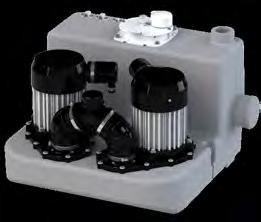
The Rheem Maximus super high efficiency gas water heater with leak sense features up to .90 UEF with built in EcoNet Wi-fi technology. Maximus is designed to give homeowners continuous hot water with an ease of install for plumbers.

House of Rohl features the Nibi collection by Riobel. The bathroom series offers a single handle lavatory faucet and is offered with two handle configurations (side or top handle) and is available in four finishes (chrome, brushed nickel, black and brushed gold).

Taco expanded its light commercial ECM pump offering with the 1911ecm, a 425watt, self-sensing, mechanically sealed pump with a max. 50 ft. of head and 105 gpm, and the 1915ecm, a 650 watt pump with 65 ft. of head and 120 gpm.


RWC’s CashAcme EB25 PLUS (PRV) brings water control technology to pressure regulators for the commercial, hi-rise and institutional markets. The flow control and pressure regulation eliminates multi-valve installations, and the single cartridge design can be installed in any orientation.
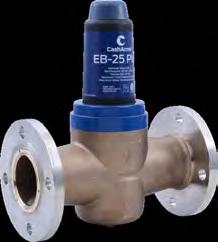
TOTO’s new commercial toilet and EcoPower flush valves feature the Tornado Flush system for a forceful centrifugal cyclonic rinsing action using only 1.28 gpf. The flush valves feature a self-powered hydroelectric system with a smart sensor and self-adjusting detection range.
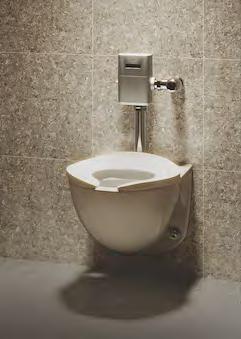

Continued on p44


42 HPAC | OCTOBER 2023 HPACMAG.COM
CIPHEX West 2023
OCT 18 th & 19 th

SHOWCASE PRODUCTS
WILL INCLUDE:

HPX-5, PTAC, Endeavor
Side-Discharge & Heat Pump,



Maximus, CRTGH Condensing
Tankless, Triton Light Duty, Proterra

Rheem.ca Experience our extensive and exciting product range
IBCBoiler.ca Visit us at BOOTH #431 to see our full range of products.
New Product Showcase



OS&B features its Total 1 bath waste, its two-in-one offset and direct bath waste configurations in one bag. Available in ABS and PVC models and multiple kit types and closure mechanisms, the Total 1 reduces the items needed on your truck.

Bibby Ste. Croix features its Husky 4000 series super-duty stainless steel coupling for joining no-hub cast iron soil pipe and fittings. Extra width for lateral support, the additional sealing clamps provide improved load distribution and positive seal.

REED’s Bevel Boss plastic pipe beveler is a cordless power method, with no gas fumes or exposed blades. A solution for large diameter plastic pipe, the Bevel Boss lets operators bevel fast, consistently and work safely.


The Bell & Gossett ecocirc 20-18 and ecocirc+ 20-18 variable speed ECM smart circulator provide efficiency, ease of use and control. A solution for heating, cooling and potable water, the versatile circulator replaces up to 70 different pumps on the market.

Cameron Instruments will be showing the MAKO Assist app that allows backflow testers, through Bluetooth, to automatically send test values to a phone where values are labeled and prepared for reporting, with or without an internet connection.





Pivot and Pivot Pro control panels from Zoeller offer diagnostics and convenience features. The Pivot 1Ph simplex and duplex panels include built-in counters and alarms, while the Pro series panels include more features including LCD screen, internet connectivity and more.
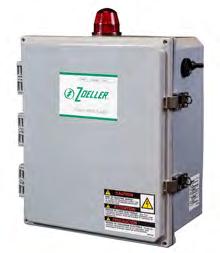

The Free Standing tub drain from Sioux Chief eliminates ‘stub ups’ for simple and fast rough-in installation. Universal design can be used with centre and offset tub outlets and the compact design fits inside tight spaces or joist cavities.

PRIER commercial hydrant options include the P-628 narrow wall hydrant with lockable stainless-steel box, and for a freezeproof version the P-754 hot and cold wall hydrant has single handle temperature mixing, double check backflow preventer and vacuum breaker.
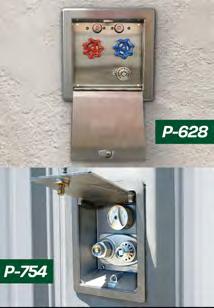
Suitable for pipe markers, tool kits and bins, the Brady portable Bluetooth M511 label printer allows users to design, preview and print up to 1.5-in.-wide labels. Through a phone users can access files, design and edit on-site.

44 HPAC | OCTOBER 2023 HPACMAG.COM







Featuringpatented V-Slice® cutter technology 2hp1hp Patent: See LibertyPumps.com/patents 800-543-2550 - LibertyPumps.com Copyright © Liberty Pumps, Inc. 2023 All rights reserved. leading the revolution in grinder technology
CIPHEX Floorplan










46 HPAC | OCTOBER 2023 HPACMAG.COM
NOW AVAILABLE
With the latest innovations & long-lasting reliability, it’s the trusted Indirect Water Heater . Contact your local distributor today.
Stainless Steel Coil Tank

Sizes: 30, 40, 50, 60, 80, 100, 120 Gallons
1” Side Boiler Connections
Top DHW Connections
3/4” (30-60) & 1” (80-120)
Factory Included: T&P Valve, 1/2” Drain Valve, Aquastat
Acid Pickling for Increased Corrosion Resistance
Scan the code now to learn more.

List current as of press time. Highlighted exhibitors have advertisements in this issue.































48 HPAC | OCTOBER 2023 HPACMAG.COM Manufacturing Drain Pumps for Over 50 Years RESIDENTIAL COMMERCIAL INDUSTRIAL Sanivite® 0.4 HP / 140° F Part No 008 Sanicom® 2 2 HP / 194° F Part No 028 Sanicom® 1 1.3 HP / 194° F Part No 018 Sanishower® 0.2 HP / 110° F Part No 010 Saniswift® 0.3 HP / 140° F Part No 021 Compact, quiet and powerful drain pumps for any type of application! 800-571-8191 • saniflo.com 800-363-5874 • saniflo.ca LEARN MORE Saniswift® Pro 0.3 HP / 140° F Part No 022 HPAC_Saniflo_Oct23.indd 1 2023-09-11 2:53 PM Exhibitor
A-B-C A.M.T.S. Ltd. 628 A.O. Smith ......................................... 515 Aalberts IPS ....................................... 101 Aimco International 730 Alltemp Products 535 Altatech Agencies 309 Amtrol 428 Aqua-Tech/Lochinvar ...................... 810 Armstrong .......................................... 427 Arthur J Gallagher 328 ASPE B.C. Chapter 608 Attersall Marketing 835 Axiom Industries 423 Barclay Sales ..................................... 217 Bay Industrial..................................... 133 Belanger 914 Belimo 734 Bibby Ste Croix 1026 BMI Canada 815 Boshart Industries 836 Bradford White.................................. 135 Brady .................................................. 717 Calefactio 235 Cameron Instruments 828 Canadian Institute of Plumbing and Heating 204 Canadian Water Quality Assoc. 506 Canature Watergroup ....................... 527 Canplas Industries ............................ 107 Cascade Flow Control Solutions 826 CB Supplies 833 Centrotherm 117 Chemfax Products ............................ 736 CM Canada ......................................... 307 Cool Estate .........................................609 D-E-F DAB Pumps 804 Daikin 1004 Delta Electronics 543 Eastern Foundry & Fittings .............. 728 ECCO Manufacturing ........................430 Ecobee 539 Enercall Sales 212 Engineered Pump 831 Equipco .............................................. 926 ESAB Group ....................................... 917 Evergreen BioHeat ............................ 507 Express Radiant 315 Fabco Plastics 715 Fairview 532 Fernco Connectors 639 FGI Canada.........................................633 Fieldboss ............................................ 231 Flexmaster Canada 614 Fluidmaster 641 Franklin Water Treatment 630 Fresh Aire UV 537
List













HPACMAG.COM OCTOBER 2023 | HPAC 49 Fujitsu 727 G-H-I Gateway Mechanical ........................ 713 GE Appliances 806 Gerber Canada 323 Giacomini Canada 520 GLP Canada ....................................... 707 Goldstone HVACR ............................. 809 Granby Industries ............................. 201 Gripple Canada 530 Grundfos 735 HBX Control Systems 732 Heat-Flo 407 HeatLink Group ................................. 738 Hometech Development ..................834 House of Rohl 904 HPAC Magazine 127 HVAC Rentals 409 HVAC Xchanger 534 Hydronic Systems Canada ............... 223 InfraAIR Duro Dyne & SUPCO 131 InSinkErator 908 IPEX 723 IPS - International Power Systems.. 227 J-K-L J.M Hasick & Associates 533 Kane Canada/ UEi 623 King Heating Products...................... 528 Klass Mechanical Sales ....................404 Liberty Pumps 636 Little Giant / Franklin Electric 326 Lyncar / Waterline 743 M-N-O M.A. Stewart & Sons 232 Mainline Backflow Products 400 Masco Canada 632 Master Group 617 Mechanical Business Media ............333 Mechanical Contractors Association of Alberta 509 Mechanical Equipment Sales 1032 Mee Group 711 Megapro Tools................................... 511 Mehta Canada ................................... 807 Mifab 739 Milwaukee Electric Tool 523 Mitsubishi Electric 330 Moen 322 Morris/Lee .......................................... 226 Navien Canada .................................. 416 NCI Canada 814 North Star Water Treatment 410 NTI 417 NUPI Americas 705 Nu-Trend Industries .......................... 610 Oatey Canada .................................... 817 OS&B 435 Continued on p50 Help customers save up to 30%* on operating costs with our ENERGY STAR®-qualified, Envirosense® high-efficiency gas water heaters, featuring commercial-grade components. *Compared to minimum efficiency 50 USG model. Energy-saving water heating solutions for busy Canadian households johnwoodwaterheaters.com Visit us at CIPHEX West – Booth 515 Envirosense SF® Envirosense® Power Vent Envirosense® Power Direct Vent HPAC_AOSmith_Oct23.indd 1 2023-09-22 11:35 AM















50 HPAC | OCTOBER 2023 HPACMAG.COM It takes hard work to become a master at your craft and your customers look to you to deliver. At Little Giant, we believe in the power of perseverance. For 80 years, Little Giant pumps have gotten the job done – delivering proven reliability for plumbers and homeowners alike. 16G 6-CIA 6-EC Among Contractors. Rated Easiest to install 2022 Little Giant Brand Research Study Visit us at CIPHEX Booth #326 littlegiant.com HPAC_Little_Giant_Brand_Lift_Plumbing_Half_Page_Ad.indd 1 9/13/23 9:59 AM HPAC_Franklin_Oct23.indd 1 2023-09-15 11:06 AM Exhibitor List P-Q-R Pentair Canada 434 Perfect Aire 541 Plumbing & HVAC ............................. 209 PremierOne Products ..................... 1016 PRIER / Stern Williams / FIAT 631 Ratech Electronics 334 RectorSeal 207 Reed Manufacturing 840 REHAU ................................................ 233 Resideo Technologies ...................... 210 Rheem Canada 414/431 RIDGID 306 RLS 304 Robinson Supply 811 Roth Industries .................................. 531 Ruck Air Movement .......................... 432 RWC: SharkBite/HoldRite/CashAcme .. 722 S-T-U Sanuvox Technologies 710 Schwank Group 720 Security Chimneys ............................643 ServiceForge ..................................... 329 ServiceTitan 412 SFA Saniflo 912 Simpro Software 529 Sinclair Supply 830 Sioux Chief Manufacturing ..............640 SJE – Rhombus .................................838 SpacePak 403 Stanley Black & Decker 310 Stringer Sales 741 Taco Comfort Solutions 821 Tamas Hydronic Systems................. 733 Taylor Walraven ................................ 606 TECA ................................................... 827 Thermo Manufacturing 111 Thryv 1030 Toto 805 Unik Pro B 305 Uponor 503 UV Dynamics 504 V-W-X-Y-Z Victaulic 627 Viega 426 Viessmann ......................................... 123 Weil-McLain ....................................... 522 Wemech Sales ................................... 829 Westlake Pipe & Fittings 300 Williams Comfort Products 1028 Wilo Canada 616 Wolseley 729 Xylem ................................................. 513 Zoeller ................................................ 920 Zurn 921
At just 38 inches tall, the LAARS® FT Series Floor Standing Boiler is the industry’s pound-for-pound champion with features including:

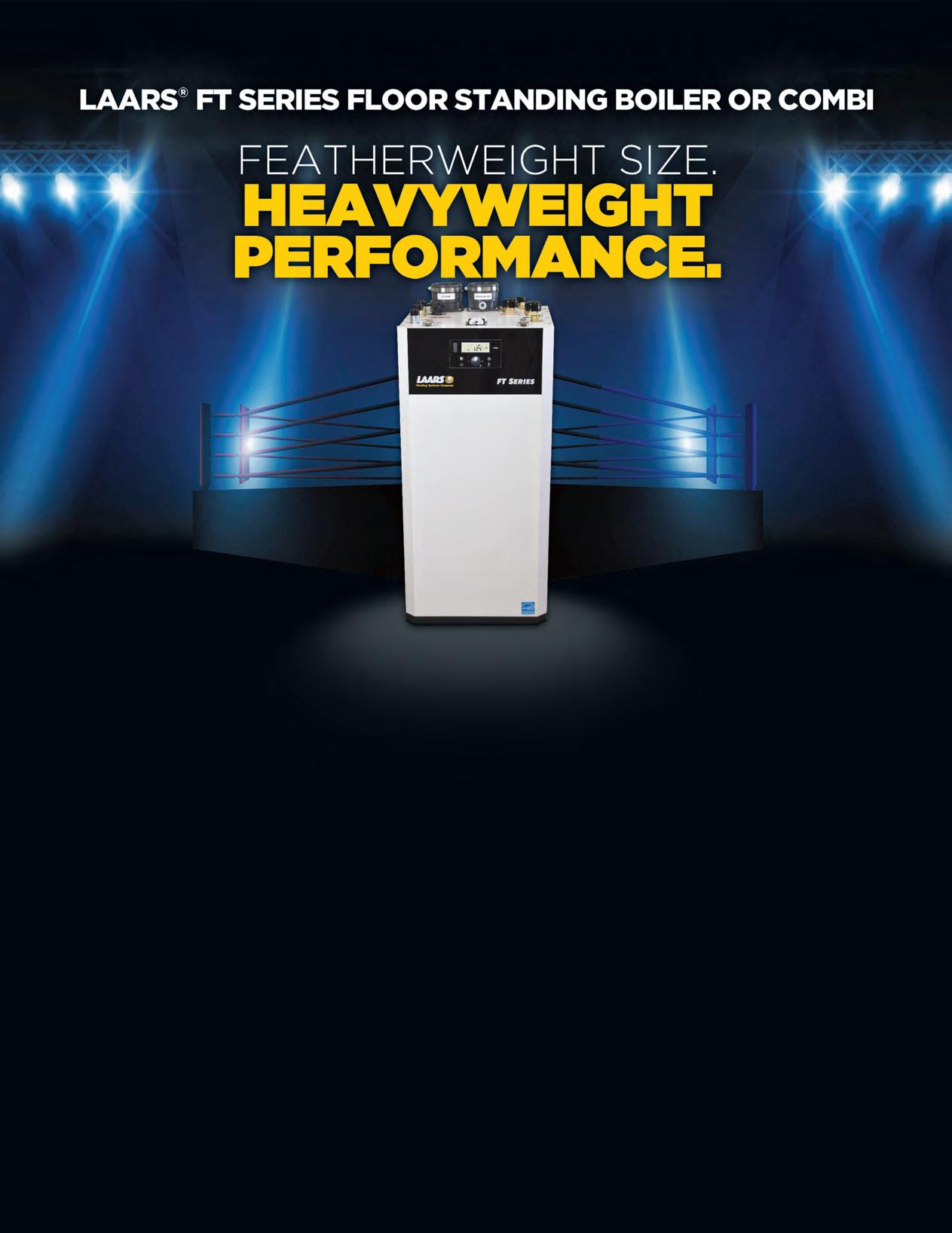
• Industry Best Domestic Hot Water Delivery from a Combi Floor Boiler:
First minute delivery of 6+ gpm at a 70˚F rise
Continuous delivery of 5.2 gpm at a 70˚F rise
• Industry Only Smart Heating Technology.

DHW Smart Priority™ technology enables the combi boiler to supply abundant space heating simultaneously with endless domestic hot water.
• FAST Hot Water Delivery. Combi boiler features a unique, integrated domestic hot water mini-indirect tank containing up to one gallon of stored hot water for immediate response.
• Easy Installation. Built-in low loss header, front and side access panels, flexible venting options, top connections, and easy fit for tight spaces.
• Ultra-High 95% AFUE Efficiency. Modulates with a 10:1 turndown for additional savings.
©2023, LAARS Heating Systems. All rights reserved. LRSHPAC1023 See this fighter’s full story at LAARS.com
us at CIPHEX West 2023
Visit
Booth #135
MECHANICAL SUPPLY NEWS
MANUFACTURERS • DISTRIBUTORS • WHOLESALERS
HRAI CONFERENCE SCORES IN MONTREAL
The concepts of teamwork and playing to win were recurring themes at this year’s three-day Heating Refrigeration and Air Conditioning Institute of Canada (HRAI) annual conference held in Montreal, September 17-19.
Being home to the hockey-mad fans of the Montreal Canadiens, the conference adopted a hockey theme along with a slogan of “More Wins.”
To kick off the event, Canadiens’ goaltending legend Ken Dryden addressed the conference attendees, which includes HVAC/R manufacturers, wholesalers/distributors, and contractors.

Dryden’s talk focused on climate change and the challenges we face both as an industry and as a nation. He zeroed in on the challenge of taking on something that’s much larger than any one of us, and something we’ve never faced before.
A winner of six Stanley Cups in the 1970s, along with being a member of the classic 1972 Canada-Russia Summit series, Dryden understands winning.
He reflected on challenges he faced in his many careers, as hockey player, lawyer, writer, educator and politician, including the shock of being called up as a rookie to start game one of the playoffs versus the Bruins in 1971.
“While I had no idea if i could do it; I didn’t know I couldn’t do it. So I just played, and found out I could,” said Dryden. The Habs went on to win the Cup that year, Dryden taking home the MVP.
“It’s the same, I think, for all of us with any big problem. We don’t know if we can handle it, we just can’t know that we can’t.”
Then he quoted former teammate Pete Mahovlich, “We gotta play it. We might as well win it.”
It’s a philosophy Dryden has adopted for life, and feels it applies to addressing
the current climate issues.
It can’t be ignored, so he believes we need to work together to make the changes required. That includes harnessing the strength of the association’s network, the complete chain from product to customer, to understand and be able to deliver workable solutions.
He also acknowledged that government and industry need to work together. “How can we make what’s good for the environment good for business too?” he asked. “It’s those who come to think this way, act this way, and do this best, who will be the future’s biggest winners.”
Other sessions during the conference
included panel discussions on the topics of the technologies that will help the built environment respond to climate issues; how a shift to electrification can be accomplished without significant infrastructure upgrades; how the industry can find, retain and grow the workforce required to meet the significant new build and retrofit challenges; and finally how will refrigerant phase outs and new refrigerant introductions affect product availability in the near future.
While no silver bullet solutions were presented, promising prospects exist, and the overall message delivered was that the need for collaboration among all industry sectors and government relations are key.
Taking on the role of national Chair of the HRAI for 2023-24 is Tara Smith, owner of Mr Furnace in Winnipeg. The 55th Chair of the association, Smith moves on from her position of Chair of HRAI’s contractor division for the past three years, and Chair of the Manitoba HRAI Chapter for 11 years. She is a strong advocate of regional chapter participation, and she will be a champion for continued teamwork in the year ahead.
HRAI also handed out awards, recognizing valuable players and industry vets.
The Award of Merit was presented to Dennis Kozina (HRAI Chair, 2019-20).
The Warren Heeley Environmental Achievement Award was presented to Ruth Talbot of CMHC (formerly NRCAN).
President’s Recognition Awards went to John Harris, (HRAI trainer); Bill Yeo, (Refrigerant Management Canada board member) and Ralph Suppa, (retiring President/CEO of CIPH).
A Life Member Award was presented to Marc Gendron, (HRAI Chair in 2017).
Next year’s HRAI conference will be held in Vancouver, September 22-24. hrai.ca

52 HPAC | OCTOBER 2023 HPACMAG.COM
Ken Dryden, Montreal Canadiens legend and HRAI Keynote speaker.
on p54
Tara Smith, HRAI Chair 2023-24
Continued

JOINTLY PRODUCED BY cmpxshow.com Interested in exhibiting at CMPX 2024? | Contact us at cmpxshow@newcom.ca Canada’s Show for the HVACR and Plumbing Industries MARCH 20–22, 2024 SOUTH BUILDINGNEW LOCATION METRO TORONTO CONVENTION CENTRE Future-proof your business at CMPX 2024 REGISTER ONLINE FOR FREE Use promo code HPAC MORE hands-on exhibits MORE groundbreaking products MORE real-world solutions MORE game-changing connections BIGGER | BETTER | BOLDER
Continued from p52
INNOVAIR ADDS ORKAN
Innovair Solutions, the Quebec-based HVAC manufacturing, distribution and marketing company (formerly known as Oullette Group), has acquired Industrie Orkan Inc. (also based in Quebec), manufacturers of Epurair brand products including ventilation systems like HRVs and related accessories, which are sold in Canada and the U.S. innovairsolutions.com
CALEFACTIO CELEBRATING FIRST DECADE
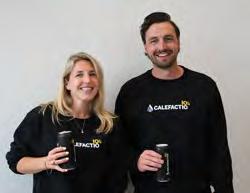
Calefactio celebrates its 10th anniversary in 2023, and to share in the festivities the company is including presents for plumbers and contractors in its packaging this fall.

Contractors will find random scratch tickets in Calefactio products sold across Canada. Overall, there will be $50,000 in prizes up for grabs. Every card’s a winner. Just over a year ago the company moved into its new 36,000 sq. ft. head office near Montreal. calefactio.com
DISTRIBUTION
>> Bartle & Gibson had announced a new regional partnership to distribute Continental HVAC products across Western Canada. bartlegibson.com
>> Wolseley opened a branch in East York. Located at 30 Bermondsey Road in Toronto, the East York store is a 29,000-sq. ft. facility offering a full range of plumbing and HVAC products. wolseleyepress.com
>> Heat-flo, the Massachusetts-based manufacturer of water heating and storage products is now partnering with Pro West Sales in B.C.; Kadin Sales in Alberta; and Westcan Mechanical Sales in Saskatchewan and Manitoba. heat-flo.com

GRUNDFOS LAUNCHES DIGITAL NEXT CIRCULATORS IN CANADA
On September 12, Grundfos Canada hosted its Digital Next product reveal in Toronto inviting contractor customers and wholesale partners from across the country to celebrate and provide hands-on training with the company’s new Digital Next series of circulators for the residential hydronics market. grundfos.com
WATTS ACQUIRING BRADLEY CORP.
Watts Water Technologies has agreed to acquire Bradley Corp. for $303 million. Bradley manufactures commercial washroom and emergency safety products serving commercial and industrial end markets. Its products include plumbing fixtures, washroom accessories and emergency safety products with annual net sales of approximately $200 million. watts.com
Continued on p56
54 HPAC | OCTOBER 2023 HPACMAG.COM < MSN
Omar Bulnes, Grundfos senior regional sales director, domestic building services – Americas, cuts a ceremonial circulator-shaped cake.
Calefactio founders Catherine and Jean-Philippe Pichette.
HPAC_HRAI_Oct23.indd 1 2023-09-25 9:33 AM
IT’S WHAT YOUR CUSTOMERS WANT!
TOTO is a brand that people trust and rely on with a reputation for comfort and innovation in the bathroom. With the inclusion of toilet features such as modern and sleek designs, heated seats, self-cleaning technology, and more…
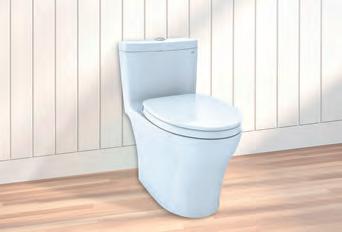
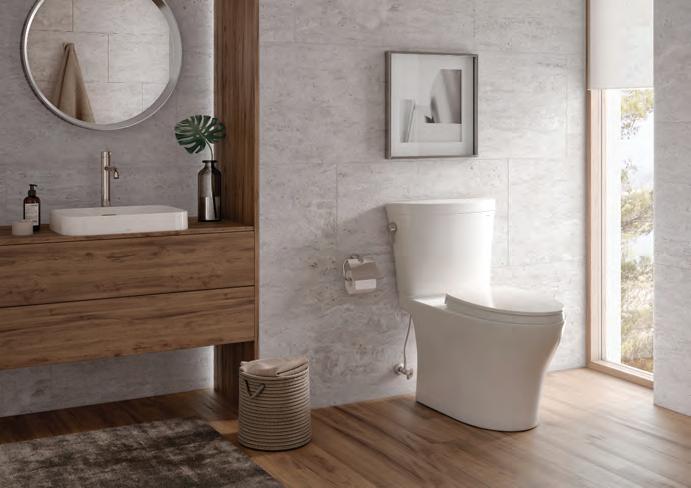
Available at NEXT has an exclusive and wide selection of high-quality TOTO bathroom products in stock, with good pricing, fast delivery and a team of experts available to help you. Contact us and ask to speak to one of our TOTO experts for more information. nextsupply.ca




 Nexus 1 piece
GO Faucet
Aquia Arc
Drake with C5 WASHLET+
Global Shower Set
Aquia IV 1 piece
Ultramax II 1 piece
Nexus 1 piece
GO Faucet
Aquia Arc
Drake with C5 WASHLET+
Global Shower Set
Aquia IV 1 piece
Ultramax II 1 piece
The Canadian Institute of Plumbing & Heating (CIPH) has announced Satinder Chera as its next CEO, following the retirement of president Ralph Suppa. Chera brings more than 20 years of senior management and leadership experience with the not-for-profit and association sectors.


Granby Industries has appointed Paul Gharghoury as the new vice president of sales Canada. Gharghoury brings over three decades of industry experience including time with Rheem Canada and Emerson White-Rodgers.

Rinnai America named Daniel Zrubak as general manager, Rinnai Canada. Zrubak has over 25 years of experience building and fostering relationships, most recently as vice president Canada, DeLonghi Canada.

Mechanical Supply has added Jay Doyle as head of sourcing. Doyle will lead sourcing and purchasing operations, leveraging his experience as a seasoned professional in these roles.

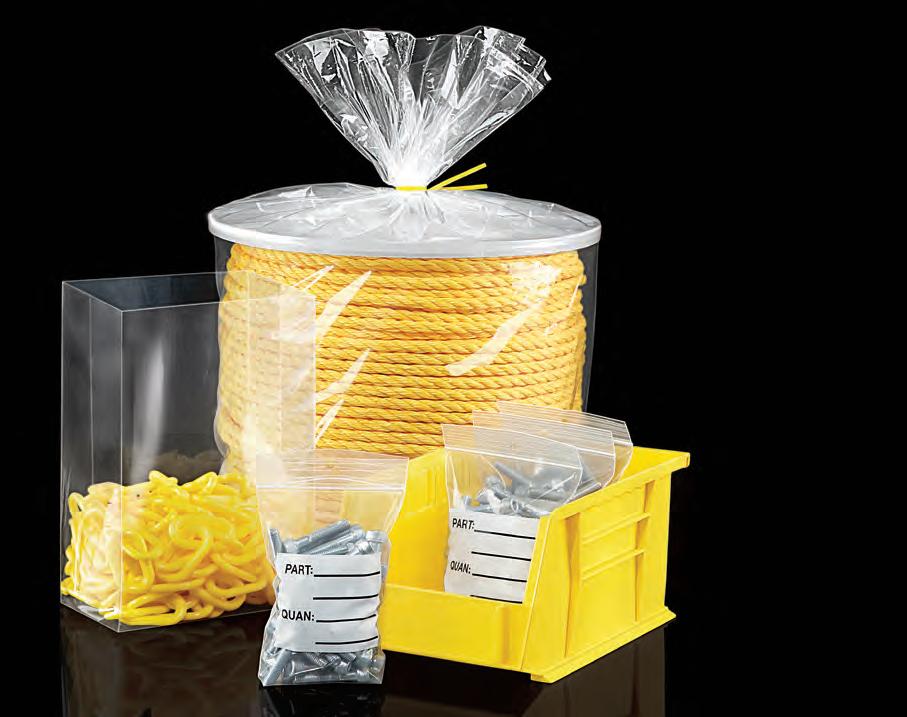
Navien Canada welcomes Mike Wills as national training manager. Wills brings over 30 years of experience in hydronics, water heating, and HVAC within the distribution sector, and he will enhance the company's training initiatives across the country.

Fernox appointed Michelle Hulett as sales director Americas, managing Canada and the U.S. Hulett is responsible for domestic and commercial heating market sales, bringing over 18 years of experience including roles with Caleffi, Eaton and, most recently, Aalberts Hydronic Flow Control.

Thermo 2000 has announced Christian Mongeon as technical sales specialist for Western Canada. In addition to his role in the west, Mongeon will also support the Quebec and Ontario teams.
NSI Industries has named John MacQuarrie the company’s HVAC Division president. MacQuarrie comes to NSI from White Distribution & Supply (WDS) where he successfully grew and sold the business while CEO.

56 HPAC | OCTOBER 2023 HPACMAG.COM < PEOPLE 23_006944_HPAC_OCT_CN Mod: September 6, 2023 1:57 PM Print: 09/13/23 page 1 v2.5 A CLEAR CHOICE OVER 3,000 POLY BAG ITEMS IN STOCK π SHIPPING SUPPLY SPECIALISTS ORDER BY 6 PM FOR SAME DAY SHIPPING COMPLETE CATALOG 1-800-295-5510 uline.ca HPAC_Uline_Oct23.indd 1 2023-09-14 3:00 PM
Chera Wills
Gharghoury
Hulett
Zrubak
Mongeon
Doyle MacQuarrie
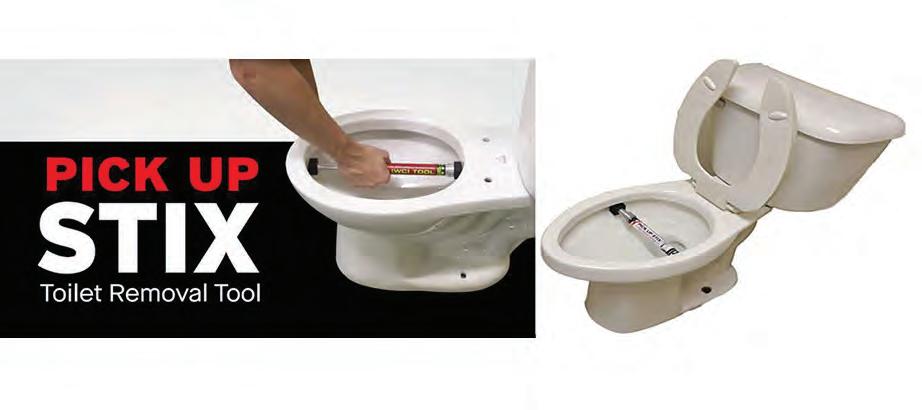

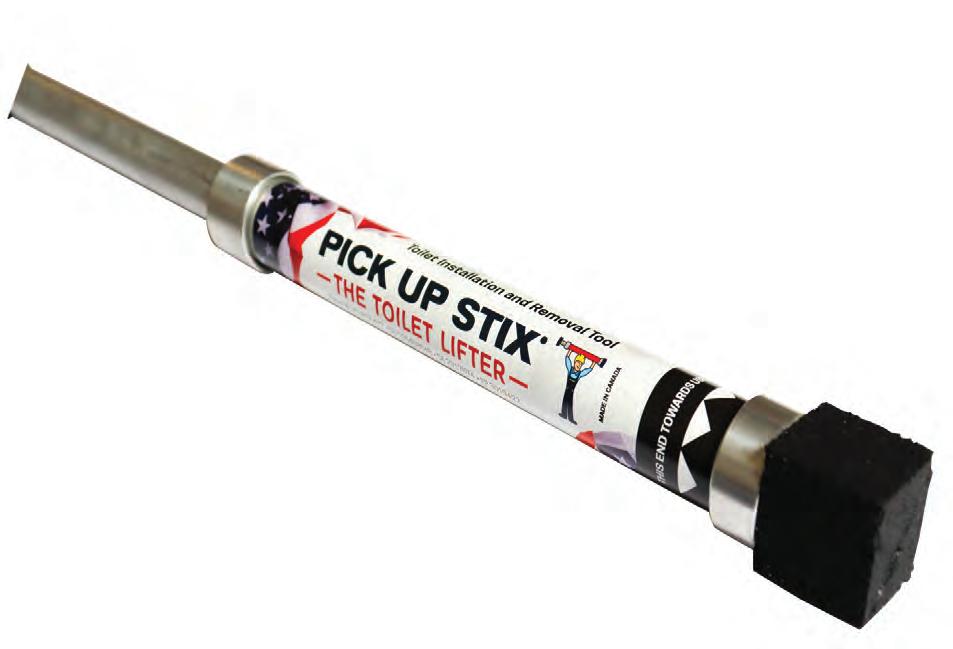
LEVINE BROS PLUMBING: 100 THANK YOUS

In celebrating its centennial, Montreal-area plumbing company gives back to its community.

 BY LUC BOILEY
BY LUC BOILEY
It’s now been over 100 years since the origin of Levine Bros. Plumbing, a residential services company in Montreal that was started in 1922 by 24-year-old Arthur Levine, who originally launched the business as A. Levine Plumbing.
It was in 1945, as more immediate family members had joined the company, that the name was changed to Levine Bros. Plumbing. Now, having now passed through four generations, the company has been expanding over the years through the acquisition of other local shops beginning in the late 1970s and continuing through the 80s, 90s and 2000s, including the addition of commercial plumbing services in the late 90s.
The company’s current president, Ben Levine, grew up in the family business and joined full time following his graduation from Concordia University’s John Molson School of Business. Starting on a truck, Ben worked his way up the ranks.
To celebrate and honour its 100 years of success, the company, now based in Lachine and servicing the entire Greater Montreal Area, decided to perform “100 Acts of Gratitude” in the form of concrete actions for thanking the city of Montréal community, the company’s customers and its employees: the three pillars that have built the family business since its founding.
Following are four examples of actions the company undertook to make a difference – small or large – in people’s lives.
RENOVATION
Following health problems which led to a job loss, a mother of six was struggling to repair her kitchen following water damage—a situation that had been going on for three months. Levine was made aware of the situation through a charita-
ble organization based in Montréal.
The company rebuilt the kitchen plumbing system, providing fixtures, parts and the labour needed. As a result, the company was happy to hear that the woman started making and selling food from her newly fixed kitchen, Continued on p60
58 HPAC | OCTOBER 2023 HPACMAG.COM
PHOTOS: LEVINE BROS:
< PLUMBING
The company undertook a complete kitchen overhaul for one family.
Company president Ben Levine was on-hand making deliveries to Moisson Montreal (food bank).
Long-time customers received thank you flowers.













What If Water Heaters Had Tinder® Profiles? A SINGLE tankless water heater system built for commercial work. intellihot.com
and that she was able to get her life back on track.
DONATIONS

Levine’s plumbers are always on the road, and while travelling on service calls, along with tools on their trucks they were also picking up and delivering food donations from their customers to Moisson Montréal, a member of Food Banks Canada and Food Banks of Quebec. Each donating customer was made eligible for a draw to win a $200 discount on their bill.
BRIGHTEN A DAY
In a move to show gratitude and add some colour to their day, the company sent flowers to some of their long-time customers as a thank you for their long-term trust.
GOOD DEEDS
During the summer, the company’s president Ben Levine and his son, Toben, spent several hours washing the plumbers’ trucks. As a major piller to the company’s success, looking after each other was a significant part of the celebration.
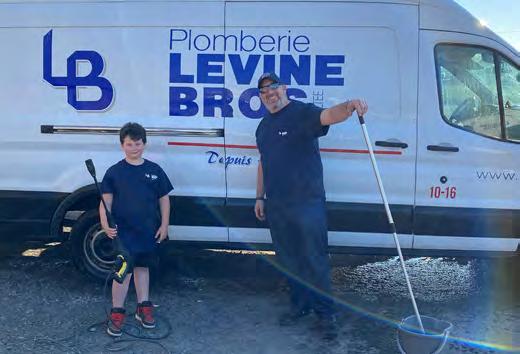
The company wanted it known that the most important thing to remember is that the Levine Bros team took at least as

much pleasure from these 100 acts of gratitude as the people who who were on the receiving end.
In the end, in a world where customers have many options for their service needs, Ben Levine personally wanted to thank the great family of customers, friends and colleagues for 100 years of valuable relationships and business. <> levinebros.ca
60 HPAC | OCTOBER 2023 HPACMAG.COM
PHOTO: LEVINE BROS:
Continued from p58
<
PLUMBING
President Ben Levine, and the next generation, his son Toben, pitched in to keep the company trucks shiny and clean.
HPAC_Giant_Oct23.indd 1 2023-09-26 10:04 AM
The only CANADIAN water heater manufacturer




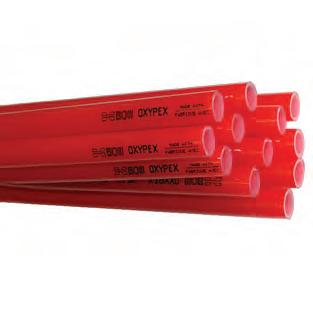


LIVING WITH A COLD CLIMATE HEAT PUMP

Despite challenges that may occur with future electrical demand, today’s heat pump technology is up to the task for this Canadian homeowner.
BY IAN McTEER
In a world where conversations once revolved around weather complaints and TV show character analyses, it now seems that the hottest topic (pun intended) on the block is none other than heat pumps.
Move over cat memes and conspiracy theories; the new kid on the block is a sleek, energy efficient, super quiet heating and cooling appliance that’s rapidly gaining celebrity status. Thanks to aggressive marketing, extensive media coverage, government and utility incentive programs including favourable impressions imparted during water cooler chats and dinner parties, many people are impressed by heat pumps.
Heat pumps have become a world-wide phenomenon. The European Heat Pump Association (EHPA) reported unit sales increased by 34% to 2.18 million units in 2022. EHPA estimates EU households have installed 16.98 million units, approximately 14% of the heating market.
In North America, governments at all levels are promoting and even subsidizing heat pump installations and energy efficient upgrades with programs like the Canada Greener Homes Grant. The City of Toronto has prepared a number of impressive heat pump case studies including several hybrid systems working along with forced warm air gas furnaces. The studies were prepared by The Sustainable Technologies Evaluation Program (STEP) of the Toronto and Region Conservation Authority (TRCA). The case studies are posted on the City of Toronto’s website.
Another metropolis, the City of New York and its Housing Authority, has undertaken a truly innovative approach to public housing energy retrofits that could have much wider applications in cities across North America. The Housing Authority has partnered with a heat pump appliance manufacturer to develop and test a cold climate heat pump window unit.
Initially, 60 heat pump window units will be installed in select public housing units. If proven to be successful, the New York Housing Authority will go ahead with a program to equip more than 30,000 public housing units with the new heat pump technology. I’m sure the tenants will be thrilled to have
cooling available during the sweltering summers of New York City.
WHAT COULD GO WRONG?
“Everything should be made as simple as possible, but no simpler,” is a remark attributed to Albert Einstein. And it seems electrification of everything fits that philosophy, because as simple as it sounds to string a bunch of wires around town to power electric heating systems and to charge electric cars, it’s just not that simple.
The Canadian Federal Government wants Canada’s electrical grid to get to net-zero by 2035. Government modelling predicts an expenditure of more than $400 billion will be required to replace aging facilities, expand solar and wind power generation and to construct more interprovincial power transmission lines. A huge battery storage capacity will be needed to help the system to adjust to peaks in demand from electric heating systems and electric vehicle changing stations.
Continued on p64
62 HPAC | OCTOBER 2023 HPACMAG.COM
< HVAC
PHOTO: DARRYL PARKS/LINKEDIN
Figure 1. A snow-covered heat pump shows a lack of installation foresight.
NOW, GIVING YOUR CUSTOMERS MORE BEGINS WITH INSTALLING LESS.
Delivering more flexibility and power in less space!
6, 8 Ton 12, 14, 16 Ton
10 Ton
Get the ultimate in comfort integration with a high-capacity unified platform, for commercial and light commercial applications.

• Expanded outdoor unit capacity, from 6 to 36 Ton

• Larger single module outdoor units – up to 16 Ton
• Up to 26% less space with larger single module outdoor units
• Both Heat Pump and Heat Recovery operation available from one unit
• Increased number of connectable indoor units
• Extended ambient air temperature operating range from -26°C to 52°C
• Intelligent refrigerant control optimizes individual zone comfort

Unified VRF outdoor units allow for heat pump or heat recovery operation for the ultimate in application flexibility.


Visit fujitsugeneral.com
more about the advantages of the AIRSTAGE VU-V
Learn
Continued from p62
The International Energy Agency said in 2022 that Canada would have to triple its electrical grid capacity by 2050 to reach the net-zero goal, yet analysists think doubling or tripling needed capacity by 2035 is doable; provided we get started right away!
Mario Chiarelli, a Toronto-based energy efficiency consultant told CBC News recently that converting Toronto’s 650,000 natural gas heated homes to top drawer inverter heat pumps would still have the effect of doubling the city’s electrical demand, increasing the load by an additional 5,000 megawatts.
No mention of the estimated electrical demand produced by the electrical conversion of residential apartment buildings along with institutional and commercial applications, many utilizing gas-fired boilers.
While the analysts hold that grid improvements, energy saving retrofits and battery storage technologies will help to reduce costs, it’s inevitable the price of electricity will rise in the short term.
Some idealists are convinced that energy costs could decline by as much as 12% by 2050 once the energy efficiency improvements have been made and reliance on volatile fossil fuel pricing has been circumvented by achieving the net zero goal.
It seems like such a monumental task, and it’s hard for me to be anything other than skeptical about massive changes to the electrical infrastructure in such a short period of time.
I’m the only one on my street with 100% electric heat. Everyone else uses natural gas. On a cold winter day (operating below my -8F (-22C) balance point) with resistance heat and the outdoor unit operating together, my system requires approximately 45 amps in total.

My neighbour’s gas furnace draws approximately 6.5 amps to run the draft inducer, fan motor and low voltage circuits. Thus, [(45 – 6.5)/6.5] x 100 = 592.31%
increase in amperage over my neighbour. There are 20 houses on my street. Admittedly, I haven’t consulted with a hydro engineer about my local electrical infrastructure, but it makes sense to me that the above ground power lines on my street would not happily pass 592% more current without a major upgrade in wire and transformer size.
Electrification is a worthy goal, however, reupping the grid so that every building gets the electrical service it needs may take decades longer than planned.
ONE STEP FORWARD, TWO STEPS BACK
In the U.K, where gas boilers once efficiently heated the average British home, air-to-water heat pump systems are being installed in ever increasing numbers. But not all is well, and Britain faces many of the same equipment related problems common to our own
HVAC industry.
Too often units are improperly specified, existing systems are not properly evaluated for pipe sizing and flow rates, and accessories like large buffer tanks are installed in attic spaces with pipes running here and there.
The lack of qualified labour, seemingly a universal problem, means too many systems simply don’t work as designed.
The Daily Telegraph reported recently that the Scottish Parliament is debating a law that would prevent homeowners from selling their properties unless they changeout an existing gas boiler for a heat pump. This unpopular idea could cost each homeowner upwards of £10,000 (CDN$17,000).
Comments and photos from across the heat pump world too often point to heat pumps failing to live up to advertised efficiency.
United States Senator, William Brownsberger, posted “mixed results” with his heat pump earlier this year on his website. He reported the system suffered a leak, but even after repairs were completed, he claimed the heat pump was so inefficient “that the environment would have benefited more if his family hadn’t installed it at all.”
I have read other comments like this, but typically no system details are ever reported. We will never know if the unit
64 HPAC | OCTOBER 2023 HPACMAG.COM
<
PHOTO: IAN MCTEER:
HVAC
Figure 2. Our indoor temperature dropped temporarily during a rare overnight low of -34C.
“Electrification is a worthy goal, however, reupping the grid...may take decades longer than planned.”


OAKVILLE 2425 Wyecroft Road, Unit #3 Oakville, Ontario L6L 6R5 T: 905-845-7558 CALGARY 15-7503 35th St. S.E. Calgary, Alberta T2C 1V3 T: 403-243-2792 The Future of Home Heating and Cooling is Here • Qualifies for the Greener Homes Rebate* • Cold climate heat pump • Pairs with existing gas furnace • Superior heating down to -30ºC • In stock Heating performance down to -30ºC 10 YEARS PARTS WARRANTY *Eligible for grant up to $5,000
was properly specified, installed into an appropriate duct system, commissioned correctly and well maintained. The refrigerant leak was truly unfortunate, but it might point to the quality of workmanship rather than the unit itself.
When I see photos of outdoor units buried in snow, it seems to me the installers are not serious about heat pump performance (see Figure 1).

MY CCASHP EXPERIENCE TO DATE
Since my Mitsubishi cold climate airsource heat pump unit was installed in September 2021 (read about it in HPAC, Dec. 2021), I can report excellent performance in both heating and cooling modes.
However, I’ve experienced several hiccups that cannot necessarily be blamed on the equipment.
I had one no heat situation in March of this year. A horrendous ice storm knocked out power in our area for 75 hours. My all-electric system remained dormant throughout, and it was cold.
I now have a gas fireplace for backup. And on January 22, 2022, I ran out of heat as the outdoor temperature had dropped to -34C. My outside design temperature is -25C, and my system has previously maintained our preferred room temperature of 21.5C down to -30C without difficulty.
The extremely low temperature lasted only a few hours and the room temperature was maintained at 17C, so no real complaint (see Figure 2, previous page).
Controlling the system became an issue. I had requested a thermostat with an internet connection. At this time, Mitsubishi does not provide an internetenabled digital controller for this system, so I opted for a 24-volt Ecobee thermostat to control my equipment using an interface.
However, there were communication problems in the heating mode that cre -
ated a few no heat and even a couple of too much heat events. Sometimes the system did not start in the heating mode even though the thermostat was clearly calling for heat, several other times the system continued heating beyond setpoint.
I’m now using a Mitsubishi digital controller that works well, but I have no internet access to my system. I understand Mitsubishi will eventually have the type of controller I’m looking for, and I have nothing bad to say about the Ecobee thermostat, it’s a great product.
FOUNDATION FAILURE
Perhaps the worst catastrophe to befall my system occurred in the spring of 2022. After several days of heavy rain combined with melting snow run-off from my septic drainage field and the roof of my modular unit (it took over a year to get my eavestrough installed!), a small river formed in front of my outdoor unit’s concrete pad and washed away a considerable amount of the gravel base, enough to undermine the pad so that it sunk down about an inch along the front side.
The outdoor unit tipped noticeably forward, fortunately there was not enough stress on the line set to cause a refrigerant leak.
After half a load of 5/8-in. base gravel and an afternoon’s worth of plate tamping, I managed to restore the integrity of the ground around the pad.
I did not risk raising the pad, I simply lifted the unit an inch and adjusted the legs so the unit is now level once again.
With the eavestrough now installed and a line of cedar trees planted in front
66 HPAC | OCTOBER 2023 HPACMAG.COM
p66
Continued from
< HVAC
PHOTO: IAN MCTEER
Figure 3. My unit secured safe and sound off the ground.
“Based on my experience, I firmly believe there are plenty of systems performing as advertised today.”
of the unit to break the wind a bit and to prevent excessive drainage into the area around the heat pump, I’m confident that my unit will continue to perform as expected (Figure 3).
POSITIVE REVIEW

I would, wherever possible, recommend a cold climate air source heat pump like mine to anyone wanting to upgrade an older central HVAC system to benefit from improved efficiency, quiet operation and top-drawer heating and cooling performance.

The system has even been embraced by local Monarch butterflies who I witnessed flitting about my outdoor unit.
I’ve found it’s best not to consult social media for hysterical stories about
Based on my experience, I firmly believe there are plenty of hybrid and cold climate systems performing as advertised in Canada today.
MORE TO BE DONE
I admire the efforts of industry groups and governmental agencies such as the aforementioned City of Toronto’s Sustainable Technologies Evaluation Program (STEP) for leading the way in demonstrating how to evaluate the heating needs of a building, then to go about specifying suitable heat pump equipment carefully installed by experts.
Heating systems of all varieties are expensive, and governments tend to throw cash at programs that may or may
niques such as improved insulation and ventilation, rather than pay for secondrate heat pump installations?
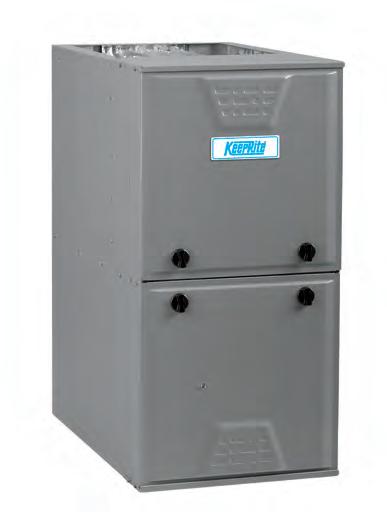
Wouldn’t it be better to have one heat pump system working properly than to have two subsidized systems working poorly or not working at all?
While an emissions-free environment is a worthy goal, electrification of everything cannot occur without dramatic improvements to the electrical grid combined with an enormous expansion of our skilled labour force, and that, in my opinion, will take decades. <>
Ian McTeer is an HVAC consultant with over 35 years of experience in the industry. He was most re -


HPACMAG.COM OCTOBER 2023 | HPAC 67
Incredible Temperature Control and Quiet Performance Ion™ 98 Variable-Speed Modulating Gas Furnace • Up to 98% AFUE • 60,000 – 120,000 BTUh • Lifetime Heat Exchanger Limited Warranty+ • 10-Year No Hassle Replacement™ Limited Warranty+ • Dual fuel capable with a compatible heat pump and thermostat for energy-saving heating performance Efficient and Powerful with No Hassle Check out our full product line-up at www.gokeeprite.com Model G97CMN + Please see warranty certificate for further details and restrictions available on www.gokeeprite.com Pair it with a compatible air conditioner for full functionality and a full communicating system using the Ion™ System Control. HPAC_ICP_Oct23.indd 1 2023-09-20 2:02 PM
CREATING HEALTHY BUILDINGS
BY NICK AGOPIAN
It’s well-known among mechanical engineers that outdoor air can mitigate airborne contaminants, but introducing unconditioned air is energy intensive. Therefore, how much outdoor air is enough to mitigate an IAQ situation such as a pandemic, or offset daily airborne CO2 or volatile organic compounds (VOC) without raising operating costs?
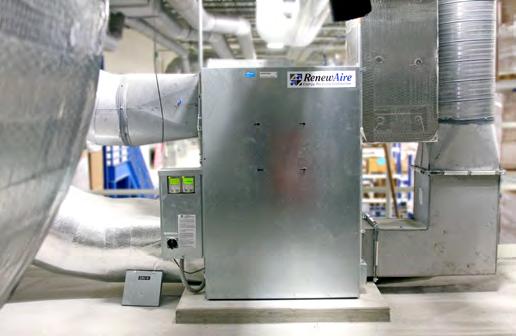
Many organizations are studying this unknown, and the WELL Building Institute, a fairly new building certification geared toward comprehensive occupant health, safety, and well-being, might suggest helpful strategies.

The WELL Health Safety Seal is an emblem a building displays that confirms it has achieved the WELL Building Standard (WELL) rating. The seal and the standard are programs created by the International WELL Building Institute (IWBI) which was formed in 2013 as a public benefit corporation that works to advance a global culture of health through better buildings.
Obviously, IAQ via outdoor air induction is a significant factor in a building performance standard, such as WELL, which has racked up 11,173 certified and rated projects, plus 18,588 enrolled projects for a total of 29,761 buildings with 2.72 billion sq. ft. in nearly 100 countries. Canada has been an active WELL country boasting dozens of buildings totaling millions of square feet that are WELL certified, such as: Oxford Properties’ 277,000-sq. ft. MNP Tower in Vancouver and 250,000- sq. ft. EY Tower in Toronto; Royal Bank of Canada lists several properties totaling hundreds of thousands of sq. ft; and in 2021 Dream Office Management Corp. became the largest commercial portfolio in Canada to achieve WELL health safety rating.
REDUCING CO2 LEVELS
Buildings earn WELL points in a variety of building categories that are applied toward gold, silver, or platinum certifications. Under the Enhanced Ventilation category applicants earn one or two points by increasing outdoor air by 30% and 60% over ASHRAE 62.1-2010 recommendations.
CO2 reduction is also emphasized in WELL and awarded points (under the Implement Demand-Controlled Ventilation category). Studies reveal that human cognitive function, productivity, and other factors are adversely affected by high concentrations of CO2 levels.
It’s not unusual for CO2 levels to rise up to 3,000-ppm in occupied spaces. The U.S. National Institute of Health (NIH) and ASHRAE both recommend CO2 levels below 1,000-ppm.
Consequently, WELL awards one, two or three points for reducing CO2 levels to 900, 750 and 600-ppm, respectively.
Incidentally, outdoor CO2 levels are approximately 425ppm, therefore diluting indoor air with outdoor air can significantly reduce indoor CO2 levels.
This is comparable to Leadership in Energy and Environmental Design (LEED), however WELL certification must be validated annually by outside evaluators in order to maintain its health and safety status.
WELL’s Enhanced Ventilation reference surpasses ASHRAE Standard 62 minimum recommendations and could be a criterion for minimizing CO2 , VOCs and even the spread of airborne pathogens.
68 HPAC | OCTOBER 2023 HPACMAG.COM Continued on p70
PHOTOS: BUSINESS WIRE, RENEWAIRE
Upgrading commercial HVAC systems with energy recovery ventilation (ERV) and dedicated outdoor air systems (DOAS) makes outdoor air affordable.
< IAQ
Participating in the WELL Building Standard ratings system is prompting building owners to increase levels of outdoor air in commercial towers.
ERVs can be added to existing air handling units (AHUs) and any building with a conventional RTU can be converted to 100% outdoor air.
VERSATILITY
Pairs with any standard furnace or air handler.
THERMOSTAT OPTIONS
Our standard 24V communication makes it compatible with most thermostats.
QUIET OPERATION
Enjoy your outdoor space noise-free, with operation as low as 59 dB(A).
INNOVATIVE TECHNOLOGY
Our inverter technology allows the unit to modulate from 35% to 100% of its capacity.
YEAR-ROUND COMFORT
Use our Atmos all year, with heating in temperatures as cold as -30°C (-22°F).

REBATE-READY
Our Energy-Star Atmos is listed on all key rebate lists, including NEEP and Greener Homes.

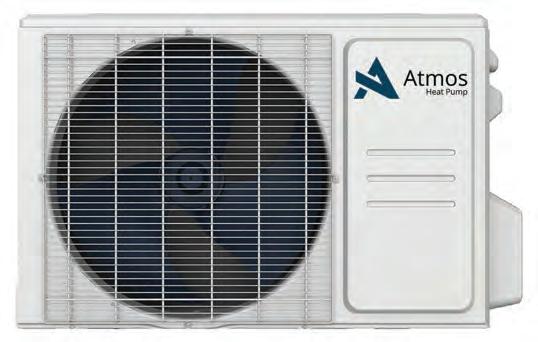
RELIABILITY


Our units are backed up a worry-free 10-year parts and compressor warranty.

www.dettson.com • 1 800-567-2733 Atmos was created for our cold climates with your comfort and happiness in mind
Pump MHD-18 & MHD-24 Atmos Heat Pump ccASHP
Central Heat
VIRUS MITIGATION
While viruses are invisible and untraceable with conventional sensor equipment, CO2 is easily monitored by sensors that can activate mitigating equipment, such as building management systems (BMS), self-controlled HVAC systems, energy recovery ventilators (ERVs) and dedicated outdoor air systems (DOAS).
If there’s potential for airborne viruses in occupied spaces, whether it’s a coronavirus pandemic or just influenza and the common cold, diluting CO2 to recommended levels is a good substitute in a scenario where there are few alternatives. The potential for high viral loads is greatly reduced if CO2 levels are also reduced through outdoor air dilution.
Public Health Ontario echoes this sentiment in its “Heating, Ventilation and Air Conditioning (HVAC) Systems in Buildings and Covid-19” document. The document specifically states, “high indoor CO2 levels can potentially identify spaces with poor ventilation rates,” but it also cautions that “CO2 is not an indicator of airborne pathogen transmission risk.”
ASHRAE has been moving toward a similar goal of increasing outdoor air. Last July it released its new Standard 241 “Control of Infectious Aerosols.” Building owners and operators can effectively reduce exposure to various pathogens, including the SARS-COV-2 virus responsible for COVID-19, as well as influenza viruses and other diseasecausing agents that inflict significant personal and economic damage each year.
The standard encompasses a wide range of requirements covering air system design, installation, operation, and maintenance.
ADDING OUTDOOR AIR WITHOUT RAISING ENERGY COSTS
Conventional HVAC systems are sized and designed to provide desired cooling and heating set points when less than
25% of outdoor air–as per compliance with ASHRAE Standard 62.1 “Ventilation for Acceptable Indoor Air Quality”–is mixed with recirculated air.
Doubling or tripling outdoor air will certainly surpass ASHRAE 62.1 IAQ compliances but will fall well short of complying with the global energy performance benchmark ASHRAE Standard 90.12019 “Energy Standard for Buildings Except Low-Rise Residential Buildings.”
When providing building owners with the flexibility of boosting outdoor air when needed, engineers add ERV equipment to both new construction and retrofit designs.
In terms of cross contamination, static plate enthalpy cores keep air streams separate, according to AHRI Standard 1060 “Performance Rating of Air-to-Air Exchangers for Energy Recovery Ventilation Equipment,” which is used to certify equipment.
Static plate enthalpy cores offer nearzero percent cross-contamination when operating with a properly balanced airflow. Instead of the energy wheel strategy of rotating through the supply and return airstreams with the same media, static plate technology completely separates the return air from the supply air during the energy exchange process.
Generally, ERVs extract heat from the exhaust air and transfer it to the supply air in winter operation. In summer, they temper the incoming hot and humid outdoor air.
This handles both latent and sensible loads and allows more outdoor air without overdriving the HVAC units’ cooling or heating capabilities.
ERVs can be applied as supplemental outdoor air units to existing AHUs, both separately or connected to the AHU itself. Depending on the size, configuration, and number of ERVs, any building with a conventional RTU can be converted to 100% outdoor air.
When specifying energy recovery equipment, it’s very important to consider the maintenance the end-user will be required to provide for the unit. While energy wheels have many moving parts i.e., rotor, wheel, belts or gears, etc., static plate enthalpy cores do not.
Many models have a leakage rate of 0.1%. The Federation of European Heating, Ventilation and Air Conditioning Associations (REHVA) backs this up with a recent position paper that stated “virus particle transmission via heat recovery devices is thought not to be an issue when a HVAC system is equipped with a twin coil unit or another heat recovery device” for separating return and supply side air stream.
RAISING STANDARDS NOT COSTS
The trend in IAQ specification today, especially in the wake of COVID-19, is to introduce more than the minimum standard of outdoor air. Healthier IAQ levels with less airborne contaminants is a positive result for occupants, but only if the additional outdoor air doesn’t cost the building owner an exorbitant operating cost. <>
Nick Agopian is vice president of sales and marketing at RenewAire. A 39-year veteran of the HVAC industry, Agopian is a member of ASHRAE TC 2.3 “Gaseous Air Contaminants and Gas Contaminant Removal Equipment” and ASHRAE SPC 62.1 “Ventilation for Acceptable Indoor Air Quality” committees. Agopian can be reached by email at nagopian@renewaire.com.
70 HPAC | OCTOBER 2023 HPACMAG.COM
p68 < IAQ
Continued from
“ERVs can be applied as supplemental outdoor air units to existing AHUs.”






Learn, connect, & level up at the event for HVACR Register for free at ahrexpo.com
SUPERMARKET COMPRESSOR REPLACEMENTS
The vapour compression cycle is the basis for nearly every refrigeration system in use, and the goal for each system is consistent and succinct: provide the correct mass flow and temperature of liquid refrigerant to the inlet of each system evaporator necessary to transfer the required heat load from each space such that the design space temperature can be maintained.
While there can be a great variety between applications, which might necessitate the use of elaborate controls, special components or accessories, each system utilizes the same four major components, each with its own specific (and rather simplistic) function. For review, here’s a simple breakdown:
Compressor: A vapour pump, which receives low pressure vapour and compresses it into a high pressure vapour. The mechanical process of compression adds heat to the vapour, so the discharge leaving the compressor always exits a higher pressure and at a temperature above saturation (superheated).
Condenser: This is one of two heat transfer surfaces present in the system, and its function is to transfer heat from the refrigerant to the atmosphere (in an air-cooled condenser) or a secondary heat transfer fluid (water-cooled condenser). In a properly sized condenser, this will allow the vapour to be transformed from a superheated vapour, to a saturated vapour (desuperheated),
then from a saturated vapour to a saturated liquid (change of state), then from a saturated liquid to a subcooled liquid.
Expansion Device: Again, the end goal of the system is to provide a saturated refrigerant at a temperature lower than the refrigerated space so that heat in the space can be transferred to it. As such, the function of the expansion device is to allow for a reduction in liquid refrigerant pressure—to a pressure that corresponds to the particular refrigerant saturation temperature required.
Evaporator: This is the other heat transfer surface present in the system, and its function is to transfer heat from the refrigerated space to the saturated refrigerant flowing through the evaporator. Since the latent heat of vaporization (amount of heat required for a liquid to undergo a change of state to a vapour) is quite high, the majority of the evaporator will have saturated liquid flowing through it to allow for efficient heat transfer. The expansion device will regulate the flow of refrigerant into the evaporator and maintain a minimum amount of superheat at the evaporator outlet, solely to prevent liquid refrigerant from flowing back to the compressor and the resulting compressor damage that it would cause.
SUPERMARKET SYSTEMS
Every supermarket chain seemingly has very similar requirements for its refrigeration equipment. However, it is inter-

esting to note that each chain has its own idea of what that perfect system is. Below are some of the more common systems in use, without reference to any particular refrigerant.
Conventional System: One compressor and condenser for each evaporator system. An evaporator system can be described as either a single evaporator, or several evaporators piped in parallel (such as three meat display cases). The method of temperature control is typically a thermostat, controlling either the compressor itself or a liquid line solenoid valve. A large roof mounted condenser, circuited to handle the heat rejection load for several individual compressor systems, may take the place of individual condensers.
Multiplex System: A derivation of the above system, using a single compressor and condenser, but connected to two or more evaporators. Each evaporator’s temperature is independently controlled, either with an evaporator pressure regulator or thermostat and liquid line solenoid valve. As with the Conventional System, the compressor may be piped to one circuit of a roofmounted multi-circuited condenser.
Parallel Rack System: This system
72 HPAC | OCTOBER 2023 HPACMAG.COM
IMAGES < REFRIGERATION
PHOTO: AJ_WATT/GETTY
DAVE
Maintenance and best practices to prevent premature failure.
DEMMA
consists of several compressors of varying capacity connected to common suction and discharge headers. The refrigeration load consists of multiple evaporator systems connected to the common suction header.
In an effort to maintain a minimum common suction pressure, the rack’s energy management system will cycle compressors on/off as required. The term “cycling” may consist of a compressor cycling on/off, or a compressor of one size cycling off while a compressor of another size cycles on.
The rack’s common suction pressure is determined by whichever connect circuit operates at the lowest temperature. Individual circuit temperature is typically controlled with an evaporator pressure regulator (EPR); by maintaining a constant pressure (refrigerant saturation temperature) in the evaporator, or an electric evaporator pressure regulator (EEPR), which responds to, and maintains a very consistent discharge air temperature.
Secondary Refrigerant: This system allows for the greatest reduction in refrigerant charge. A Parallel Rack is still utilized, but its combined capacity is mated with a secondary heat exchanger used to

provide a constant flow/temperature of a secondary heat transfer fluid (glycol, CO2, or some other proven heat transfer medium) to the primary heat exchangers (walk-in boxes or display cases).
The heat load from the refrigerated fixtures is transferred to the secondary fluid, which is in turn transferred to the refrigerant via the secondary heat exchanger.
COMPRESSOR COMPLICATIONS
Typically, a well-designed refrigeration system has no need of field modification. And, while there are exceptions to every rule, when a compressor replacement is required the replacement compressor should be the same model as the original compressor in use. This will ensure that the compressor rack operates as designed.
There are occasions where the system has been altered, maybe adding/ removing display case lineups which would result in a different Btu capacity requirement for the compressor rack. In a circumstance such as this, a discussion with the compressor rack manufacturer would be in order.
Given the four major system components discussed above, the compressor is the heart of the system. Without it,
there is no refrigerant flow.
Regardless of whether it’s a reciprocating piston, scroll or screw compressor, if the system is commissioned correctly and undergoes scheduled maintenance the compressor should live a long life.
To provide some “facts” for the above statement, here are some statements regarding failed compressors from various compressor manufacturers:
• Approximately 30% of all compressors pulled from the field, returned to manufacturers, and torn down for failure analyses do not have observable defects. (Copeland/Emerson)
• 60% to 70% of returned failed compressors are the result of system/service-related issues, or the result of misdiagnosis. (Carrier Corp.)
• 80% of compressors returned for electrical motor failure were system caused by mechanical failures that progressed into an electrical failure. (Carrier Corp.)
• 95% of alleged warranty failures turned out to be caused by external influences from the refrigeration system itself – that is to say the compressor was not at fault. (Bitzer Corp.)
• 0.25% (that’s ¼ of 1%, or 1 out of every 400) of total UK compressor sales resulted in actual valid warranty claims. (Bitzer Corp.)
I could cite more, but you get the general idea: (1) many compressors are misdiagnosed as failed when in fact there is nothing wrong; (2) for many compressors that have suffered a failure in the field, the cause was misdiagnosed; and (3) the rate of compressors that fail during the warranty period due to some kind of manufacturing defect is quite small.
LESSON FROM THE FIELD
Here’s a poignant illustration of the above statistics: early in my career as an apprentice technician I accompanied a “seasoned” journeyman technician to replace a “failed” compressor.
Continued on p74
HPACMAG.COM OCTOBER 2023 | HPAC 73
REFRIGERATION
Continued from p73
Some compressors have internal overloads imbedded in the motor windings, which will open when the motor winding temperature exceeds a rating.
The compressor in question would not start due to some situation which caused the motor temperature to increase above the overload rating, and they opened. The technician diagnosed this as a failed motor and made arrangements to replace the compressor.
The owner of the contracting company arrived at the job as the crane was lifting the compressor off the roof. He brought up his “old” Simpson 260 meter and checked the motor for continuity, and he found that the motor winding resistance was per specification.
The motor had cooled down, allowing the overloads to reset (close). Since the compressor replacement had already been approved, and to avoid a situation which exposed the technician’s costly misdiagnosis, the owner instructed us to proceed with the compressor replacement, even though there was nothing wrong with the compressor. It was a system condition which led to the motor winding overloads opening.
COMPRESSOR CONTAINMENT
The potential for a costly compressor replacement in a typical supermarket is great, simply due to the quantity of compressors in use. I would liken the typical supermarket refrigeration system to a Ferrari, sophisticated and costly. From an asset management standpoint, it makes sense to invest in regularly scheduled maintenance.
Some of the items of importance to long compressor life include:
Maintain clean condenser coils
• Lower discharge pressure will reduce stress on bearings.
• Lower discharge pressure will reduce motor amperage.
• Lower discharge temperature will pre -
vent oil from decomposing, and losing its lubricating ability.
• Lower compression ratio will allow compressor to operate more efficiently.
Electrical Inspection
• Worn motor contactor/starter contacts can cause voltage imbalance, leading to motor failure.
• Loose wiring at breaker or contactor/ starter lugs can cause voltage imbalance, leading to motor failure.
• Check compressor motor amperage to ensure it’s operating within spec.
Check oil failure control operation, monitor compressor oil pressure
• Should a compressor suffer low oil pressure, a defective oil failure control will allow the compressor to continue operating, resulting in failed bearings.
• Low oil pressure could be the result of compressor flooding, which damaged the oil pump.
• Low oil pressure could be the result of excessive bearing clearance (worn bearings).
• Low oil pressure might be the result of liquid refrigerant in the oil.
Notate oil condition
• Discolored oil is the result of overheating. Overheating will reduce the oil’s lubricating ability and also produce harmful contaminants in the system.
• Yearly oil analysis will reveal whether there are harmful chemical contami-
nants, moisture, or metal components in the oil—all the symptom of a system problem.
Maintain clean evaporator coils
• A dirty evaporator coil will reduce heat transfer efficiency and lead to issues maintaining temperature.
• More importantly, the reduced heat transfer efficiency can result in liquid floodback, which can result in severe compressor damage.
Monitor pressure loss across filters and filter-driers
• A partially plugged liquid filter-drier may not be directly responsible for a compressor failure, but it will result in starving expansion valves. This might cause a technician to change expansion valve settings to reduce the superheat set-point, which could result in floodback once the plugged filterdrier has been replaced.
• Excessive pressure drop in a suction filter can reduce suction vapour velocity to the point where oil return is impeded.
• Excessive pressure drop in a suction filter will cause compressors to operate at a higher compression ratio, reducing efficiency and increasing discharge temperature.
• A plugged oil filter can inhibit the flow of oil from the oil separator/reservoir to the compressors.

ROOT CAUSES
When a compressor suffers a failure it is of the utmost importance to determine the root cause of failure..
Another case in point: a service call revealed an inoperative compressor due to a tripped circuit breaker. After ensuring that the crankcase had no liquid refrigerant in it, the circuit breaker was reset. The breaker immediately tripped.
The three-phase power supply to the compressor motor terminals was dis -
74 HPAC | OCTOBER 2023 HPACMAG.COM
<
The damaged rotor
connected, and the motor windings were checked to see if they were shorted to ground. Using a volt-ohm meter it was verified that they were.
The compressor and compressor contactor were replaced. Liquid and suction filter-driers were replaced. The motor voltage and amperage were checked. Same with the oil pressure.
After the replacement job was finished, the new compressor appeared to be operating properly.
Well then, it must have just been a bad motor. A thorough investigation and compressor autopsy revealed the root cause of failure:
Why did the motor short? The compressor’s main bearings had failed, causing the motor stator to drop, make contact with the rotor, and absolutely destroy the motor windings.
Why did the main bearings fail? The compressor crankcase was full of sludge, which partially plugged the crankcase oil
pump inlet screen. This resulted in a loss of lubrication.
Why didn’t the oil failure switch prevent the compressor from operating with low oil pressure? Well, it seems this system had suffered repeated oil failure trips. One creative technician decided these were simply “nuisance” oil failure trips. To eliminate the “nuisance”, he jumped the L and M terminals in the oil failure control, preventing it from ever opening the control circuit. So, the compressor was allowed to operate during periods of low oil pressure, causing the main bearings to fail. Eventually, this allowed the stator to drop down, make contact with the rotor and destroy the windings. The seeming root cause of this failure is the loss of lubrication, which can be answered by the sludge which partially plugged up the pump inlet screen.
Where did the sludge come from? This is the real root cause of the failure.
This can be blamed on; (1) the thermodynamic properties of R-22, which result in high discharge temperature in low temp. refrigeration applications; and (2) lack of preventative maintenance, which resulted in a dirty condenser, leading to higher than normal discharge temperature. The high discharge temperature caused the mineral oil to decompose, forming sludge, and ... well, you know the rest of the story.
Moral of the story: an autopsy is absolutely imperative to prevent repeat compressor failures. <>

Dave Demma holds a degree in refrigeration engineering and worked as a journeyman refrigeration technician before moving into the manufacturing sector where he regularly trains contractor and engineering groups. He can be reached at ddemma@uri.com.

WE’RE GROWING AND SO CAN YOU!
We have multiple job openings at Refrigerative Supply Limited (RSL) throughout our Branches, Distribution Centers and Head Office.
With more than 18 Branches and 4 Distribution Centers throughout Western Canada, RSL has been in the industry since 1945 and has earned the ‘Great Place to Work’ certification. Inspire Excellence and Trust


www.rsl.ca/careers

HPACMAG.COM OCTOBER 2023 | HPAC 75
To ensure our employees perform the best, we offer • Sick days • Vacation days • Personal obligation days
Extended health, dental and vision care
Wellness account
Registered pension plan
Annual $3,500 tuition reimbursement
24/7 employee assistance program Send your resume to peopleandculture@rsl.ca for countless opportunities at a company that is collaborative, community-focused and innovative! HPAC_Refrigerative_MayJune_23_TD.indd 1 2023-04-20 8:43 AM
•
•
•
•
•
MAKE PURCHASING GREAT AGAIN
How to streamline your processes and free up your time.
BY MATHEW POTTINS
Irecently read a book called “Buy Back your Time” by Dan Martell, a Canadian entrepreneur. The book is essentially a breakdown of how to implement processes in your company (or your life) to free up time so you can focus on other things. Other things could include additional income generating ideas, focusing on your health or spending time with your family. The complete title of the book is: Buy Back Your Time: Get Unstuck, Reclaim Your Freedom and Build Your Empire.
In this article I want to focus on freeing up your time when it comes to procurement—that process you use to obtain or purchase goods or services for your business. And not just freeing up your time but making procurement more efficient and reliable.

Let’s first talk about some essentials when it comes to your business and procurement.
RELATIONSHIPS: VENDORS AND DISTRIBUTORS
Having been on the manufacturing and distribution side of the business, I can tell you there are always favours done for customers, but you have to be a good customer. That doesn’t necessarily mean you need to buy a million dollars a month, but being a consistent customer who pays bills and doesn’t cause headaches goes a long way.
Once the relationship is established the vendors can help you out with certain parts or equipment, but more importantly wholesalers will give you
certain access: access to payment terms, including discounts; bulk purchase benefits; and priority access to new products.
Understanding payment terms and the way cash flow can be used to your advantage will help you grow your business. Why not take advantage of 30-, 60- or 90-day terms. Earn your money from your projects and pay your bills at a later date. Leverage your cash.
INVENTORY MANAGEMENT: HOLD PRODUCT IF YOU CAN
Yes, this concept ties up your cash and may be a little counterintuitive to the previous point, but these two concepts can go hand in hand. If you can bulk purchase and get discounts on those items then you’ll make more money per unit which ultimately increases your cash (it always comes back around to cash).
Now, if you can bulk purchase you can also invest in inventory software, and this will help you understand usage patterns, reorder points, lead times and help you restock properly.
And here’s a secret, you could likely do this better than some of the distributors out there because you’re lean and mean.
DIFFERENTIATION AND COMPETITIVE EDGE: YOU’RE ON A WHOLE NEW LEVEL
How could another company compete with you when your procurement is so efficient?
You have products readily in stock, at better pricing, and with cash on hand
ready to be deployed. You’re building a foundation that will propel you to win more jobs.
Not only that, but you can use your process as a selling feature: “Hey Mrs. Homeowner, this is how I run my company. We have everything down to a science including our purchasing, so we are ready to install or service at a moment’s notice.” Bam, job sold.
SOFTWARE SOLUTIONS
Okay, so now let’s talk about software. Yes, spreadsheets are great, however I could go blind looking at tabs all day.
Besides, as I stated in the beginning, I want to make procurement more efficient and free up your time.
Before we can actually do the purchasing, we need to know what we are purchasing. You can subscribe to mechanical estimating software like Trimble Autobid or Fastest, programs that will provide full take off and material lists for you. This software has monthly or yearly subscription rates, but it doesn’t add up to how much you need to pay yourself.
How long does it take for you to properly survey a project and upload all the pertinent information to your Excel file and then send it out for quoting? This type of software will save you days of work, money, and help you grow your business by being even more accurate
76 HPAC | OCTOBER 2023 HPACMAG.COM
ZINKEVYCH/GETTY IMAGES
PHOTO:
< MANAGEMENT
with your bids.
Then we get into the actual procurement. The fun stuff, the back and forth and multiple quotes and highlighters and printed paper all over the place,
THE SOURCE
ADVERTISERS IN THIS ISSUE
and Excel sheets after Excel sheets trying to determine the best price and the most convenient locations.
And, you have to make sure that what you ordered actually comes through accurately, or that the person in charge of ordering orders the right parts or equipment.
Instead of all the headaches and the stress of analyzing quotes and paying bills on time why not use new software that is available to us. Although not yet available in Canada, Bluon is a good example of a software company that can provide pricing and availability based on location, and you can pay right through the app.
Ply procurement is another one that can take the weight of the world off your shoulders. Not only will this solution actually purchase on your behalf, but it will provide you with a dedicated buyer to do all the leg work once you send your material list from the take off software.
They analyze your spending habits, follow your inventory levels and do much more. Neither of these are subscription based, so upfront costs are not a concern.

Now imagine that, you buy a software that does a complete take off for you with 99% accuracy. And you use a purchasing software with no monthly or upfront fee. And in the process, you’ve gained your eight hours of sleep that you need, and you’ve made your company exceptionally more efficient in purchasing and organization.
I call that a win. <>
Mathew Pottins has worked with HVAC manufacturers and suppliers for over a decade, and his passion is in growing the industry. Pottins launched Laylan Hydronics and HVAC Sales and can be reached at mathew@laylanhvac.com.
HPACMAG.COM OCTOBER 2023 | HPAC 77 Adrian Steel adriansteel.com p.12 AERCO aerco.com/combination p.21 AHR Expo ............................ahrexpo.com .................................. p.71 American Standard americanstandard.ca/flash p.13 AquaTech Lochinvar.com p.29 Bradford White bradfordwhite.com p.25, 51 Caleffi caleffi.com p.27 Chemfax ..............................chemfax.com ................................... p.2 CMPX cmpxshow.com p.53 Delta DeltaFaucet.ca/Commercial p.39 Dettson ...............................dettson.com.................................. p.69 Flocor Inc flocor.ca p.11 Franklin Electric ................littlegiant.com ............................... p.50 Fujitsu fujitsugeneral.com p.63 General Pipe Cleaners drainbrain.com/XPodPlus p.5 Giant ....................................giantinc.com ................................. p.60 GLP Canada glpcanada.com p.65 Grundfos Grundfos.to/HPAC2023 p.17 IBC IBCBoiler.ca p.43 InSinkErator Canada insinkerator.emerson.com p.7 Intellihot..............................intellihot.com ................................ p.59 Intertek Intertek.com/HVACR p.14 John Wood ..........................johnwoodwaterheaters.com ........ p.49 Keeprite gokeeprite.com p.67 Liberty Pumps LibertyPumps.com p.45 LYNC ....................................lyncbywatts.com/aegis ................. p.15 Lyncar lyncar.com p.57 Mits Air mitsair.com p.23 Navien..................................navieninc.com .......................... p.9, 37 NEXT Supply nextsupply.ca p.55 Refrigerative Supply rsl.ca/careers p.75 Reliance Worldwide ..........sharkbite.com............................... p.79 Ruud Canada ruud-canada.ca p.80 Saniflo saniflo.ca p.48 Thermostat Recovery Program .............hrai.ca/trp..................................... p.54 Triangle Tube triangletube.com p.47 Uline uline.ca p.56 Uponor .................................uponor.com/askforuponor ........... p.31 Velocity Boiler Works VelocityBoilerWorks.com p.19 Viessmann viessmann.ca p.33 Wavin ...................................waivin.us ........................................ p.61
THE
EVENT
CIPHEX West
October 18 – 19
CIPHEX West 2023 brings a full plumbing and heating tradeshow and conference to the BMO Centre at Stampede Park in Calgary. ciphexwest.ca
The Buildings Show
November 29 – December 1
Canada’s leading event for the broad construction industry returns to the Metro Toronto Convention Centre and incorporates a trade show and extensive conference program. thebuildingsshow.com
AHR Expo
January 22 – 24
The Air conditioning, Heating, Refrigeration (AHR) Expo heads to Chicago’s McCormick Place Convention Center to showcase the latest in technology advancements for the industry. ahrexpo.com
MEET Show
May 1 – 2
The Mechanical Electrical Electronic Technology (MEET) show is returning to Moncton, taking place at the Moncton Coliseum Complex. This will be the 25th edition of the biennial event that features the latest equipment, products, and technology all on display for contractors in Atlantic Canada and beyond. meetshow.ca
MCAC Annual Conference
October 18 – 21
The Mechanical Contractors Association of Canada (MCAC) is heading to wine country this fall as it will be holding its Annual National Conference at the Silverado Resort in Napa Valley, California. mcac.ca
IGSHPA Annual Conference
December 5 – 7
The International Ground Source Heat Pump Association is holding its annual gathering in Las Vegas with the theme, Geothermal: The Genius Renewable. The three-day event has an extensive conference agenda with Canadian content. igshpa.org
KBIS
February 27 – 29

The Kitchen & Bath Industry Show (KBIS), North America’s largest show dedicated to all aspects of kitchen and bath design with displays from the industry’s largest names in faucets and fixtures, returns to Las Vegas. kbis.com
CIPH Annual Business Conference
June 16 – 18
The 2024 CIPH Annual Business Conference will take place in Kelowna, B.C. This marks the 91st anniversary of the national association for manufacturers and distributors of products and services for Canada’s plumbing and heating industry. ciph.com
Decarbonization Conference for the Built Environment
October 25 – 27
Being held in Washington, D.C., this ASHRAE hosted event will be an information and idea exchange, between stakeholders in the built environment industry, concerning the timely and important topic of reducing carbon emissions from buildings. ashrae.org
ASHRAE Winter Conference
January 20 – 24
This year’s conference, as in year’s past, will coincide with the AHR Expo being held in Chicago with the conference programming taking place at the Marriott Marquis McCormick Place. Virtual live streaming is also available. ashrae.org
CMPX 2024
March 20 – 22
The Canadian Mechanical & Plumbing Expo is moving to the south building at the Metro Toronto Convention Centre in downtown Toronto. CMPX is Canada’s largest event for the plumbing and HVAC/R industry. cmpxshow.com
ASHRAE Annual Conference
June 22 – 26
The global Society of Heating, Refrigerating and Air-Conditioning Engineers will be holding its four-day annual conference in Indianapolis. The program will cover how legislation, electrification, AI and other factors are affecting the industry ashrae.org
78 HPAC | OCTOBER 2023 HPACMAG.COM
2023
HPACMAG.COM
Planning an event? Send the details to editor@hpacmag.com Visit event websites for the most current updates and registration details. 2024
FOR
LATEST
NEWS, SEE HPAC'S NEWSLETTER @
CALENDAR
EVEN better under pressure
The new patented SharkBite Max fittings give you double the burst pressure, while only requiring half the insertion effort to push onto the pipe.
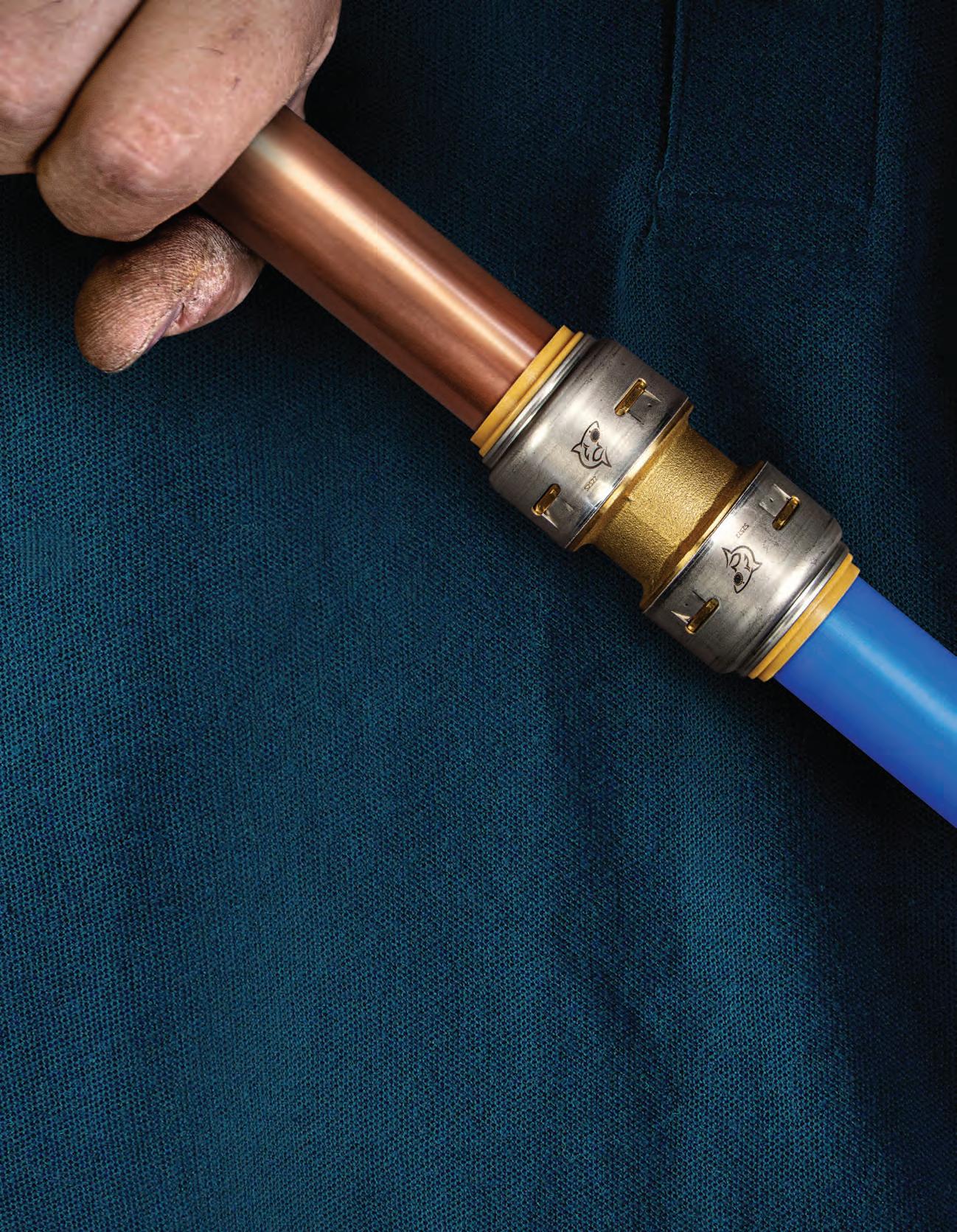
So when you need stronger and faster, there’s no substitute for the Shark.
THE BURST PRESSURE
THE INSERTION FORCE
STAINLESS STEEL REINFORCED COLLAR AND PATENTED TECHNOLOGY
EXPERIENCE OUR EXTENSIVE AND EXCITING PRODUCT RANGE



CIPHEX West 2023

OCT 18th & 19th
SHOWCASE PRODUCTS WILL INCLUDE:



PTAC, Side Discharge, Endeavor, Maximus, CRTGH Condensing Tankless, Triton Light Duty, Proterra, HPX-5

VISIT US AT BOOTH #431 & #414 TO SEE OUR FULL RANGE OF PRODUCTS.

RUUD-CANADA.CA









 By John Siegenthaler
By John Siegenthaler

 By Dan Vastyan
By Dan Vastyan





 By HPAC Staff
By HPAC Staff
 By Luc Boiley
By Luc Boiley





 By Nick Agopian
By Nick Agopian

 By Dave Demma
By Dave Demma





















 Model: UPSe 15-58F P/N: 92603106
DIGITAL ALPHA
Model: ALPHA 15-58F P/N: 92603115
Model: UPSe 15-58F P/N: 92603106
DIGITAL ALPHA
Model: ALPHA 15-58F P/N: 92603115








 HPAC STAFF
HPAC STAFF

































































































































































 Nexus 1 piece
GO Faucet
Aquia Arc
Drake with C5 WASHLET+
Global Shower Set
Aquia IV 1 piece
Ultramax II 1 piece
Nexus 1 piece
GO Faucet
Aquia Arc
Drake with C5 WASHLET+
Global Shower Set
Aquia IV 1 piece
Ultramax II 1 piece














 BY LUC BOILEY
BY LUC BOILEY


































































